Marketing Strategy for Huawei Technologies
VerifiedAdded on 2023/04/07
|32
|4948
|58
AI Summary
This report provides insights into Huawei's marketing strategy, including its strengths, weaknesses, opportunities, and threats. It also examines the company's competitive edge and growth potential.
Contribute Materials
Your contribution can guide someone’s learning journey. Share your
documents today.
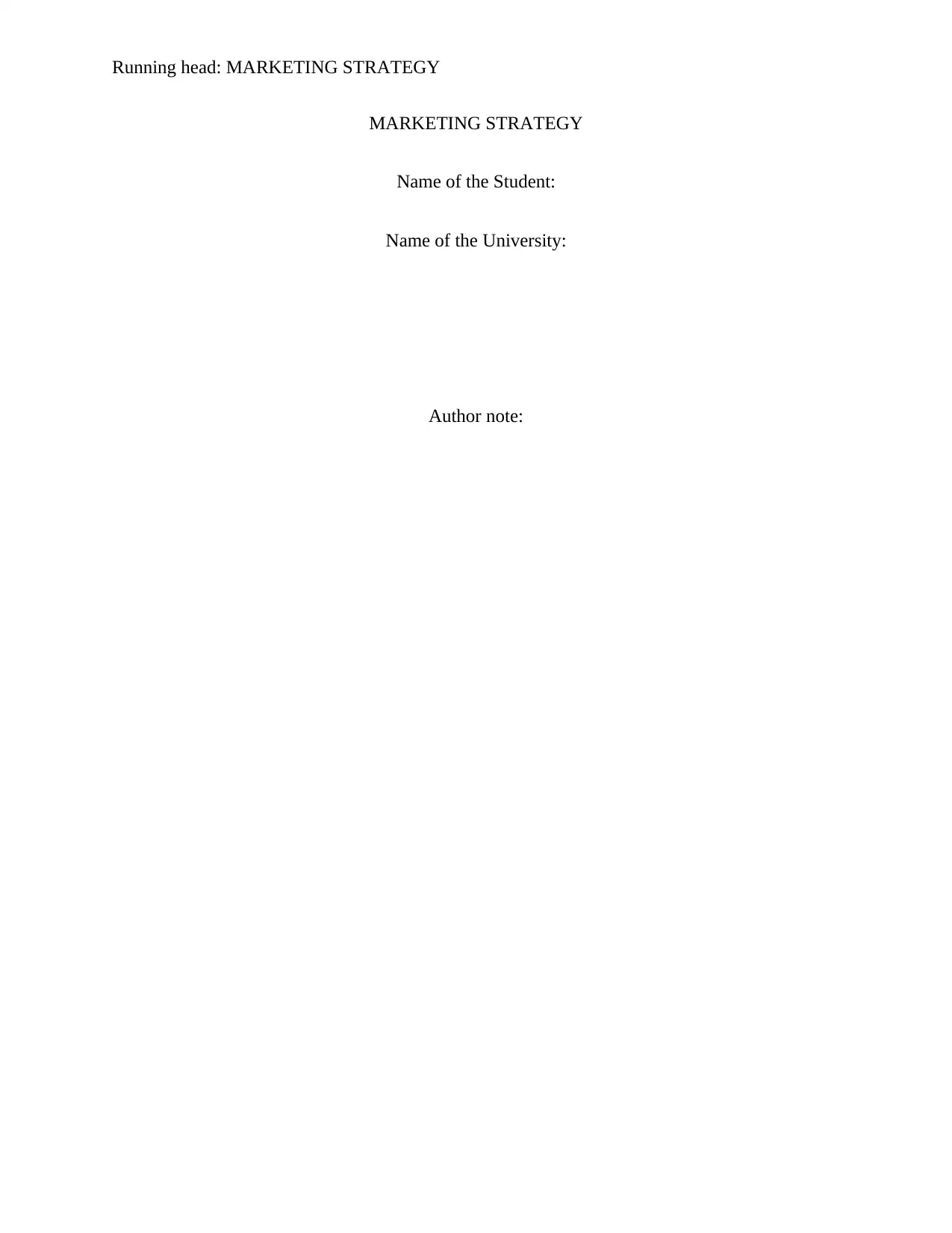
Running head: MARKETING STRATEGY
MARKETING STRATEGY
Name of the Student:
Name of the University:
Author note:
MARKETING STRATEGY
Name of the Student:
Name of the University:
Author note:
Secure Best Marks with AI Grader
Need help grading? Try our AI Grader for instant feedback on your assignments.
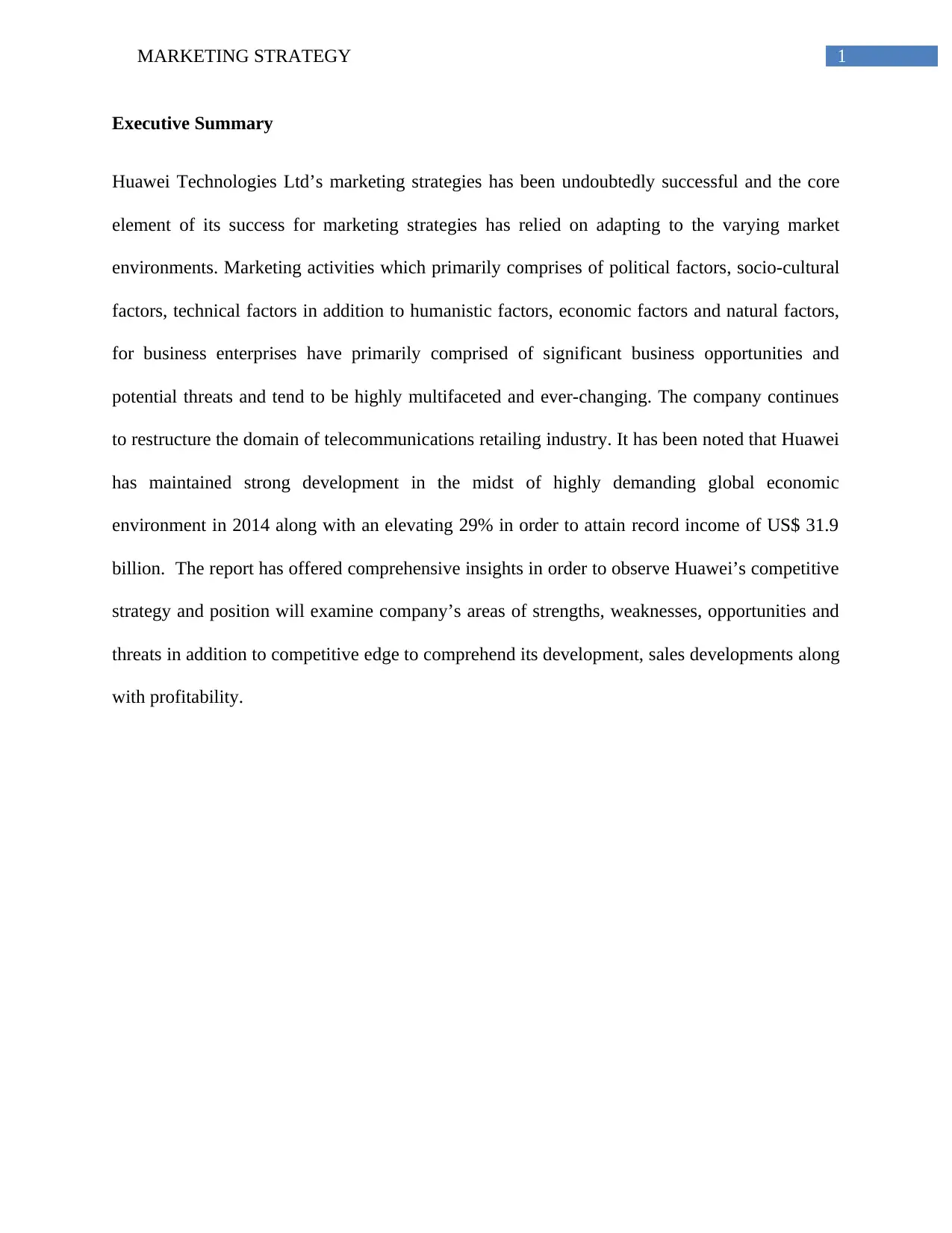
1MARKETING STRATEGY
Executive Summary
Huawei Technologies Ltd’s marketing strategies has been undoubtedly successful and the core
element of its success for marketing strategies has relied on adapting to the varying market
environments. Marketing activities which primarily comprises of political factors, socio-cultural
factors, technical factors in addition to humanistic factors, economic factors and natural factors,
for business enterprises have primarily comprised of significant business opportunities and
potential threats and tend to be highly multifaceted and ever-changing. The company continues
to restructure the domain of telecommunications retailing industry. It has been noted that Huawei
has maintained strong development in the midst of highly demanding global economic
environment in 2014 along with an elevating 29% in order to attain record income of US$ 31.9
billion. The report has offered comprehensive insights in order to observe Huawei’s competitive
strategy and position will examine company’s areas of strengths, weaknesses, opportunities and
threats in addition to competitive edge to comprehend its development, sales developments along
with profitability.
Executive Summary
Huawei Technologies Ltd’s marketing strategies has been undoubtedly successful and the core
element of its success for marketing strategies has relied on adapting to the varying market
environments. Marketing activities which primarily comprises of political factors, socio-cultural
factors, technical factors in addition to humanistic factors, economic factors and natural factors,
for business enterprises have primarily comprised of significant business opportunities and
potential threats and tend to be highly multifaceted and ever-changing. The company continues
to restructure the domain of telecommunications retailing industry. It has been noted that Huawei
has maintained strong development in the midst of highly demanding global economic
environment in 2014 along with an elevating 29% in order to attain record income of US$ 31.9
billion. The report has offered comprehensive insights in order to observe Huawei’s competitive
strategy and position will examine company’s areas of strengths, weaknesses, opportunities and
threats in addition to competitive edge to comprehend its development, sales developments along
with profitability.
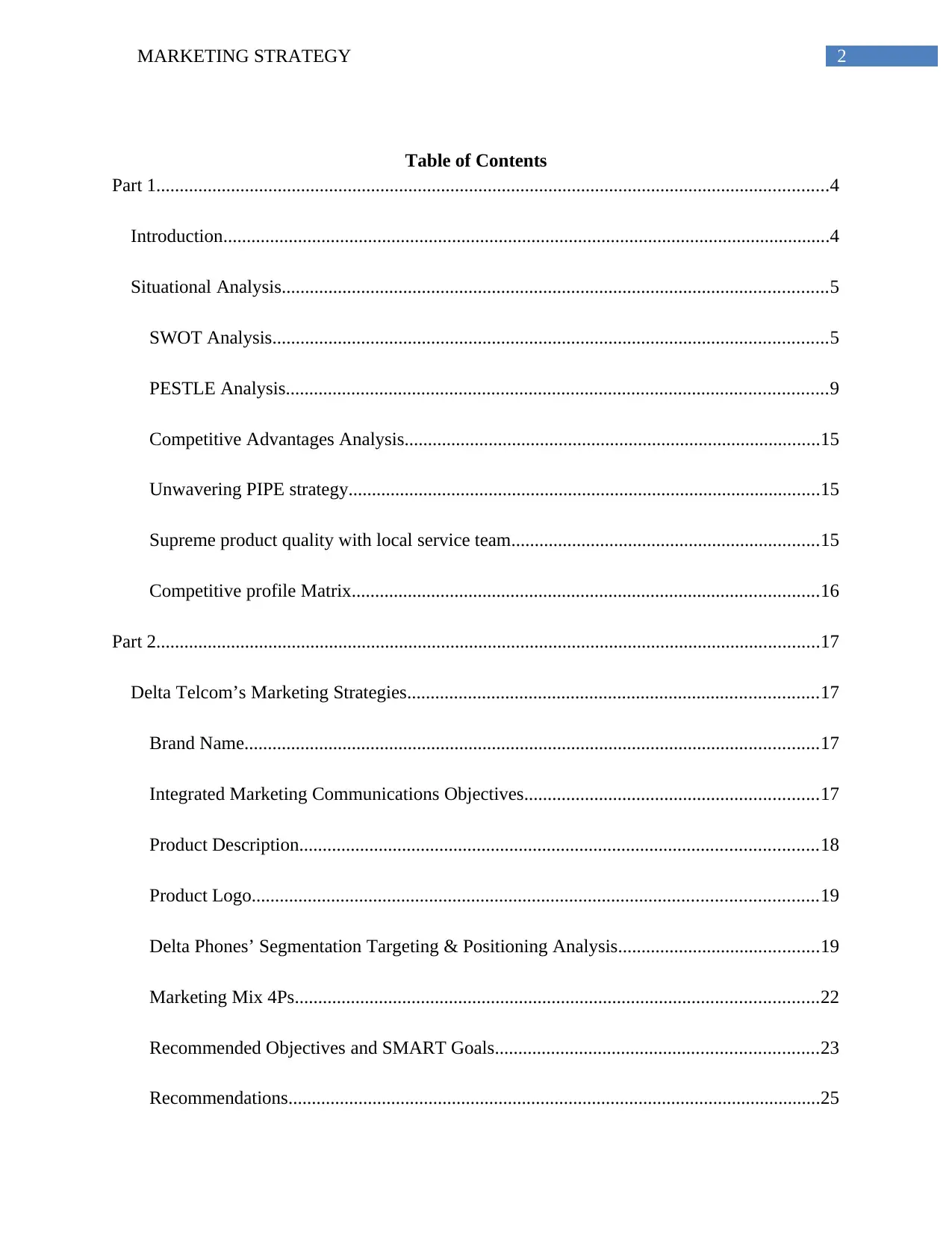
2MARKETING STRATEGY
Table of Contents
Part 1................................................................................................................................................4
Introduction..................................................................................................................................4
Situational Analysis.....................................................................................................................5
SWOT Analysis.......................................................................................................................5
PESTLE Analysis....................................................................................................................9
Competitive Advantages Analysis.........................................................................................15
Unwavering PIPE strategy.....................................................................................................15
Supreme product quality with local service team..................................................................15
Competitive profile Matrix....................................................................................................16
Part 2..............................................................................................................................................17
Delta Telcom’s Marketing Strategies........................................................................................17
Brand Name...........................................................................................................................17
Integrated Marketing Communications Objectives...............................................................17
Product Description...............................................................................................................18
Product Logo.........................................................................................................................19
Delta Phones’ Segmentation Targeting & Positioning Analysis...........................................19
Marketing Mix 4Ps................................................................................................................22
Recommended Objectives and SMART Goals.....................................................................23
Recommendations..................................................................................................................25
Table of Contents
Part 1................................................................................................................................................4
Introduction..................................................................................................................................4
Situational Analysis.....................................................................................................................5
SWOT Analysis.......................................................................................................................5
PESTLE Analysis....................................................................................................................9
Competitive Advantages Analysis.........................................................................................15
Unwavering PIPE strategy.....................................................................................................15
Supreme product quality with local service team..................................................................15
Competitive profile Matrix....................................................................................................16
Part 2..............................................................................................................................................17
Delta Telcom’s Marketing Strategies........................................................................................17
Brand Name...........................................................................................................................17
Integrated Marketing Communications Objectives...............................................................17
Product Description...............................................................................................................18
Product Logo.........................................................................................................................19
Delta Phones’ Segmentation Targeting & Positioning Analysis...........................................19
Marketing Mix 4Ps................................................................................................................22
Recommended Objectives and SMART Goals.....................................................................23
Recommendations..................................................................................................................25
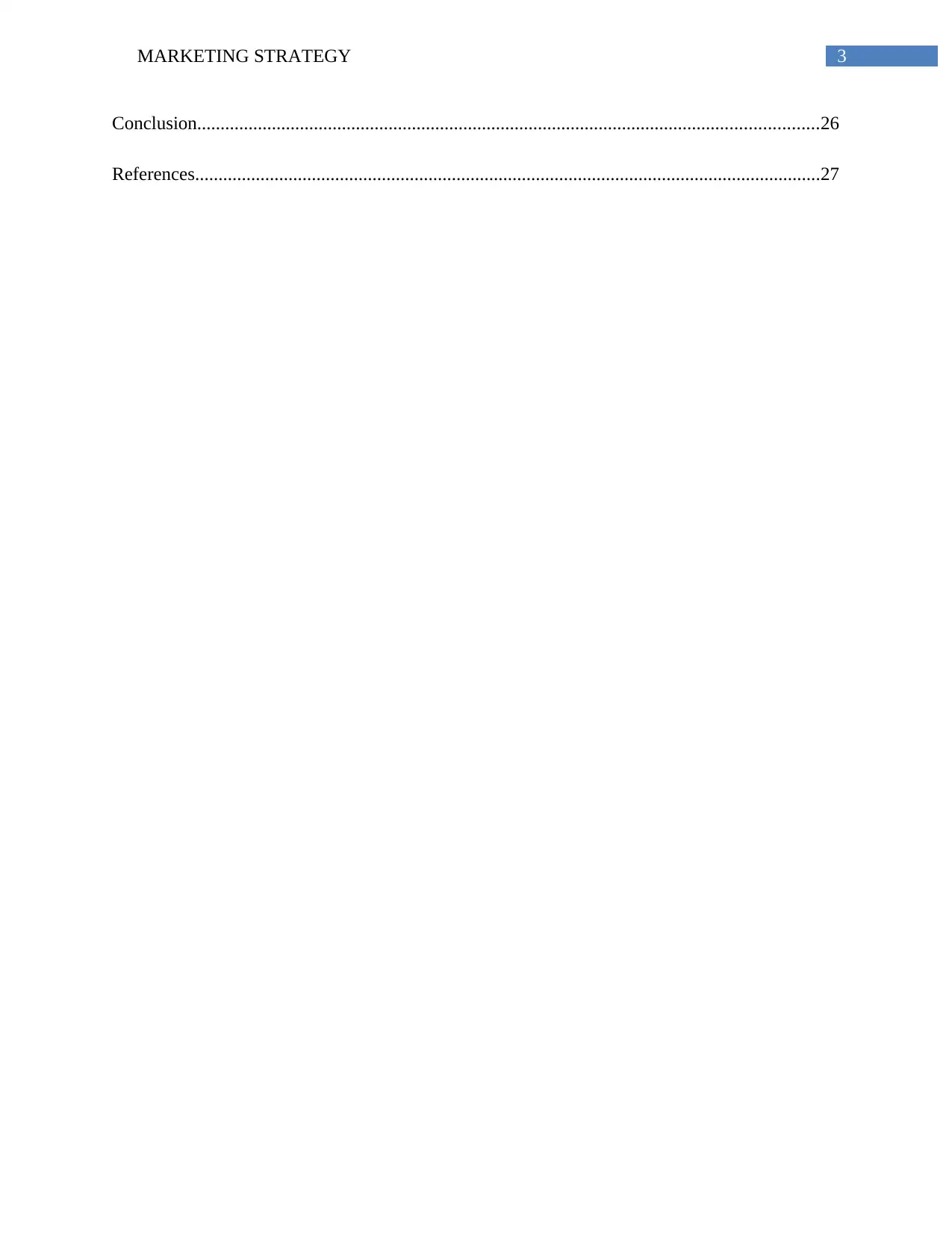
3MARKETING STRATEGY
Conclusion.....................................................................................................................................26
References......................................................................................................................................27
Conclusion.....................................................................................................................................26
References......................................................................................................................................27
Secure Best Marks with AI Grader
Need help grading? Try our AI Grader for instant feedback on your assignments.
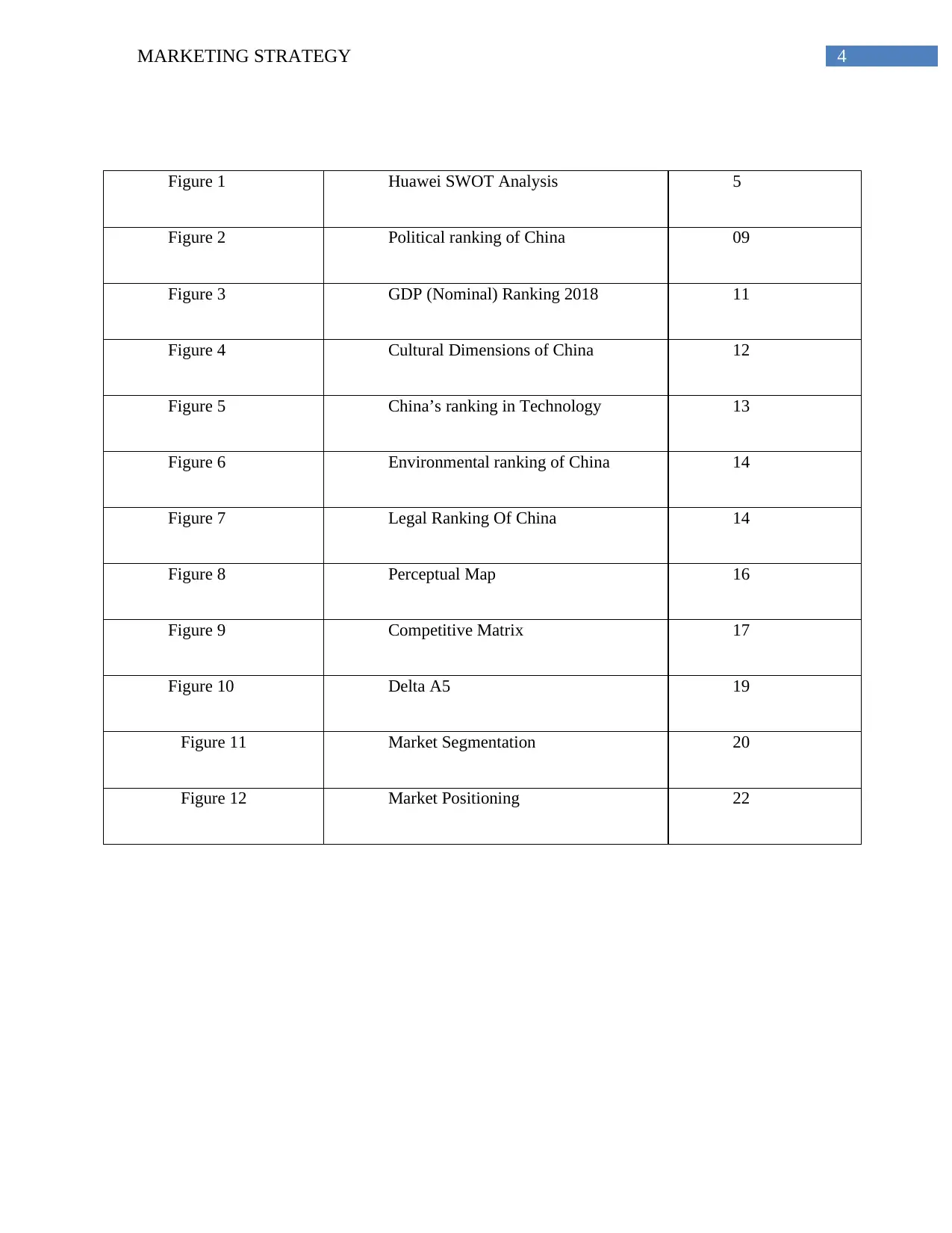
4MARKETING STRATEGY
Figure 1 Huawei SWOT Analysis 5
Figure 2 Political ranking of China 09
Figure 3 GDP (Nominal) Ranking 2018 11
Figure 4 Cultural Dimensions of China 12
Figure 5 China’s ranking in Technology 13
Figure 6 Environmental ranking of China 14
Figure 7 Legal Ranking Of China 14
Figure 8 Perceptual Map 16
Figure 9 Competitive Matrix 17
Figure 10 Delta A5 19
Figure 11 Market Segmentation 20
Figure 12 Market Positioning 22
Figure 1 Huawei SWOT Analysis 5
Figure 2 Political ranking of China 09
Figure 3 GDP (Nominal) Ranking 2018 11
Figure 4 Cultural Dimensions of China 12
Figure 5 China’s ranking in Technology 13
Figure 6 Environmental ranking of China 14
Figure 7 Legal Ranking Of China 14
Figure 8 Perceptual Map 16
Figure 9 Competitive Matrix 17
Figure 10 Delta A5 19
Figure 11 Market Segmentation 20
Figure 12 Market Positioning 22
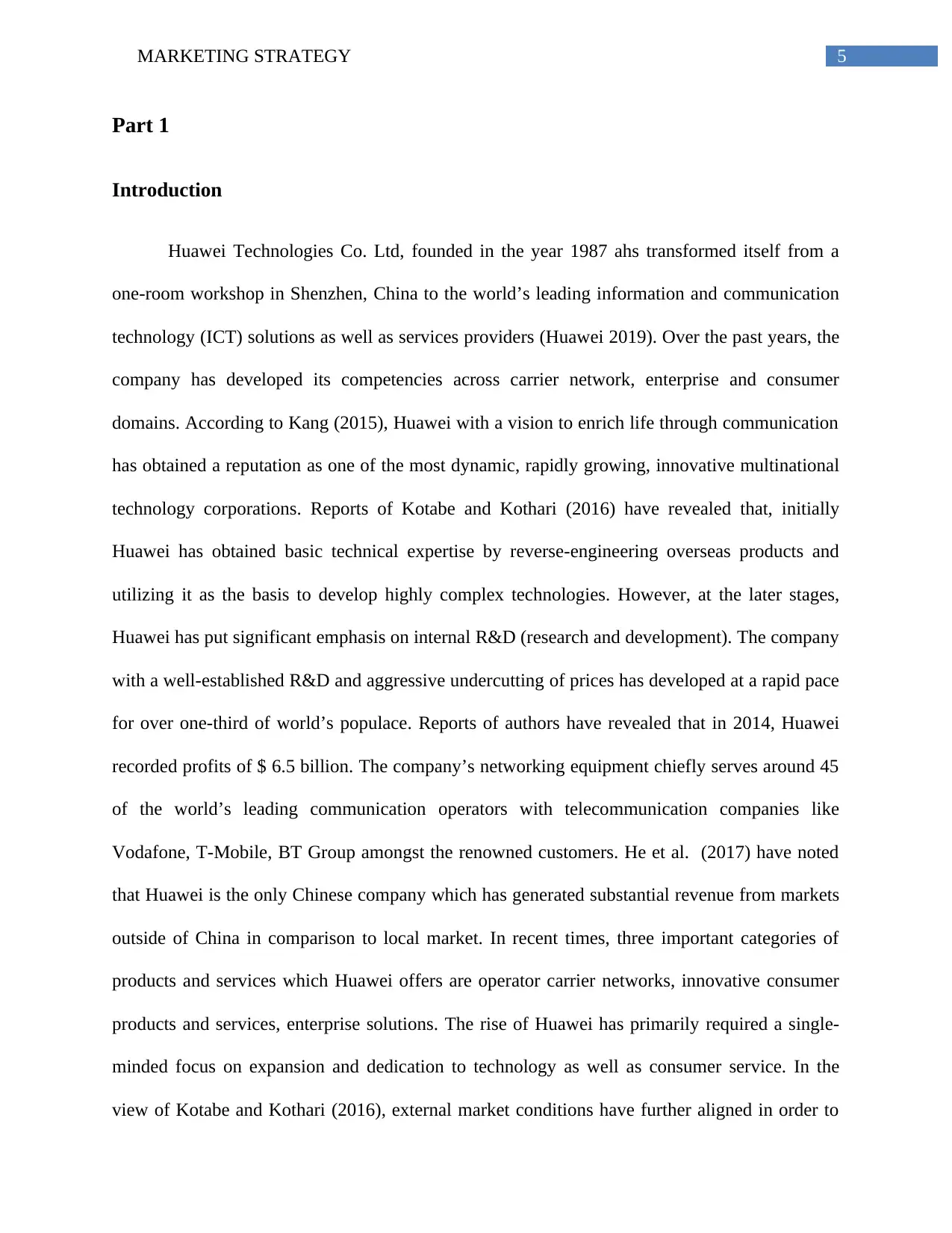
5MARKETING STRATEGY
Part 1
Introduction
Huawei Technologies Co. Ltd, founded in the year 1987 ahs transformed itself from a
one-room workshop in Shenzhen, China to the world’s leading information and communication
technology (ICT) solutions as well as services providers (Huawei 2019). Over the past years, the
company has developed its competencies across carrier network, enterprise and consumer
domains. According to Kang (2015), Huawei with a vision to enrich life through communication
has obtained a reputation as one of the most dynamic, rapidly growing, innovative multinational
technology corporations. Reports of Kotabe and Kothari (2016) have revealed that, initially
Huawei has obtained basic technical expertise by reverse-engineering overseas products and
utilizing it as the basis to develop highly complex technologies. However, at the later stages,
Huawei has put significant emphasis on internal R&D (research and development). The company
with a well-established R&D and aggressive undercutting of prices has developed at a rapid pace
for over one-third of world’s populace. Reports of authors have revealed that in 2014, Huawei
recorded profits of $ 6.5 billion. The company’s networking equipment chiefly serves around 45
of the world’s leading communication operators with telecommunication companies like
Vodafone, T-Mobile, BT Group amongst the renowned customers. He et al. (2017) have noted
that Huawei is the only Chinese company which has generated substantial revenue from markets
outside of China in comparison to local market. In recent times, three important categories of
products and services which Huawei offers are operator carrier networks, innovative consumer
products and services, enterprise solutions. The rise of Huawei has primarily required a single-
minded focus on expansion and dedication to technology as well as consumer service. In the
view of Kotabe and Kothari (2016), external market conditions have further aligned in order to
Part 1
Introduction
Huawei Technologies Co. Ltd, founded in the year 1987 ahs transformed itself from a
one-room workshop in Shenzhen, China to the world’s leading information and communication
technology (ICT) solutions as well as services providers (Huawei 2019). Over the past years, the
company has developed its competencies across carrier network, enterprise and consumer
domains. According to Kang (2015), Huawei with a vision to enrich life through communication
has obtained a reputation as one of the most dynamic, rapidly growing, innovative multinational
technology corporations. Reports of Kotabe and Kothari (2016) have revealed that, initially
Huawei has obtained basic technical expertise by reverse-engineering overseas products and
utilizing it as the basis to develop highly complex technologies. However, at the later stages,
Huawei has put significant emphasis on internal R&D (research and development). The company
with a well-established R&D and aggressive undercutting of prices has developed at a rapid pace
for over one-third of world’s populace. Reports of authors have revealed that in 2014, Huawei
recorded profits of $ 6.5 billion. The company’s networking equipment chiefly serves around 45
of the world’s leading communication operators with telecommunication companies like
Vodafone, T-Mobile, BT Group amongst the renowned customers. He et al. (2017) have noted
that Huawei is the only Chinese company which has generated substantial revenue from markets
outside of China in comparison to local market. In recent times, three important categories of
products and services which Huawei offers are operator carrier networks, innovative consumer
products and services, enterprise solutions. The rise of Huawei has primarily required a single-
minded focus on expansion and dedication to technology as well as consumer service. In the
view of Kotabe and Kothari (2016), external market conditions have further aligned in order to
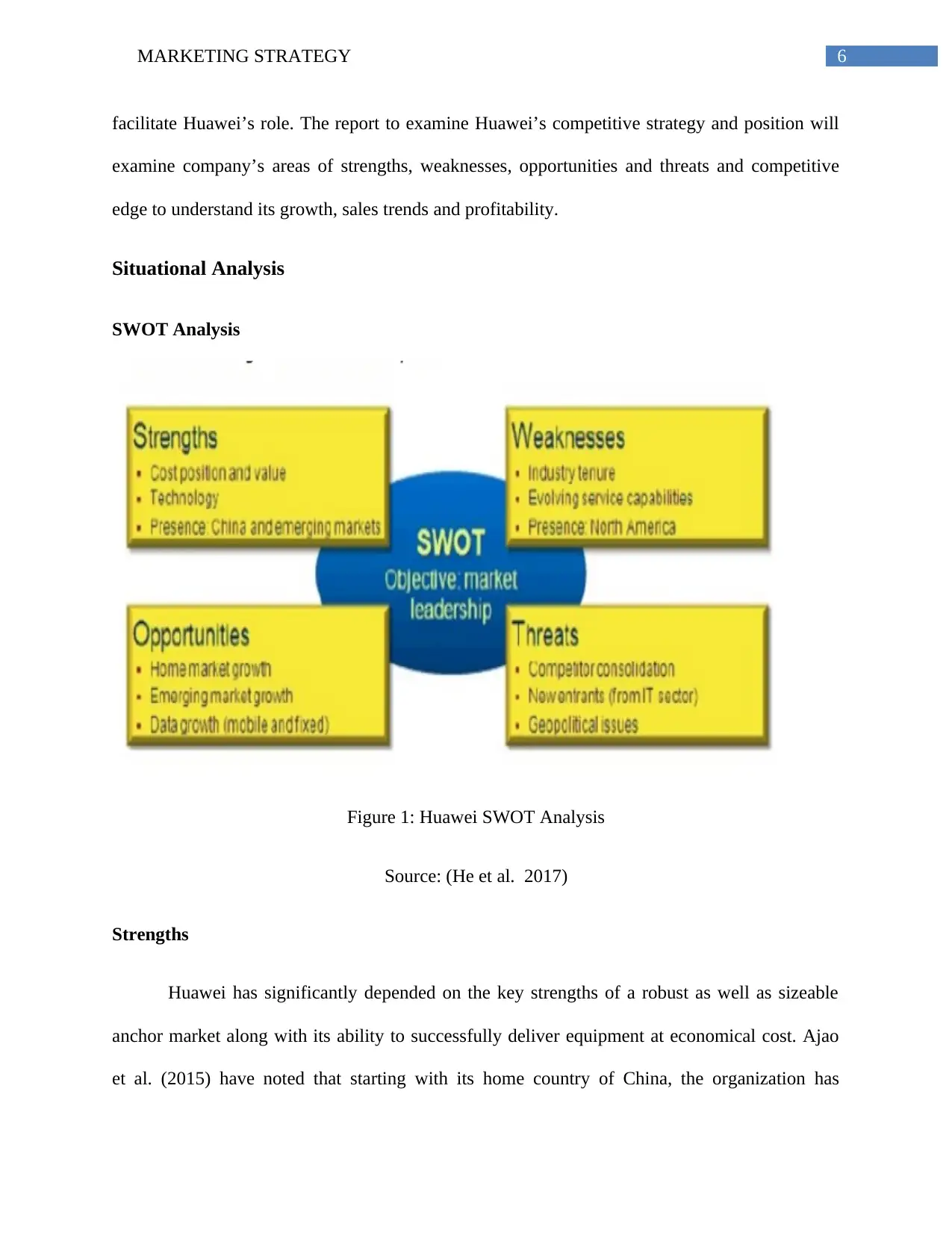
6MARKETING STRATEGY
facilitate Huawei’s role. The report to examine Huawei’s competitive strategy and position will
examine company’s areas of strengths, weaknesses, opportunities and threats and competitive
edge to understand its growth, sales trends and profitability.
Situational Analysis
SWOT Analysis
Figure 1: Huawei SWOT Analysis
Source: (He et al. 2017)
Strengths
Huawei has significantly depended on the key strengths of a robust as well as sizeable
anchor market along with its ability to successfully deliver equipment at economical cost. Ajao
et al. (2015) have noted that starting with its home country of China, the organization has
facilitate Huawei’s role. The report to examine Huawei’s competitive strategy and position will
examine company’s areas of strengths, weaknesses, opportunities and threats and competitive
edge to understand its growth, sales trends and profitability.
Situational Analysis
SWOT Analysis
Figure 1: Huawei SWOT Analysis
Source: (He et al. 2017)
Strengths
Huawei has significantly depended on the key strengths of a robust as well as sizeable
anchor market along with its ability to successfully deliver equipment at economical cost. Ajao
et al. (2015) have noted that starting with its home country of China, the organization has
Paraphrase This Document
Need a fresh take? Get an instant paraphrase of this document with our AI Paraphraser
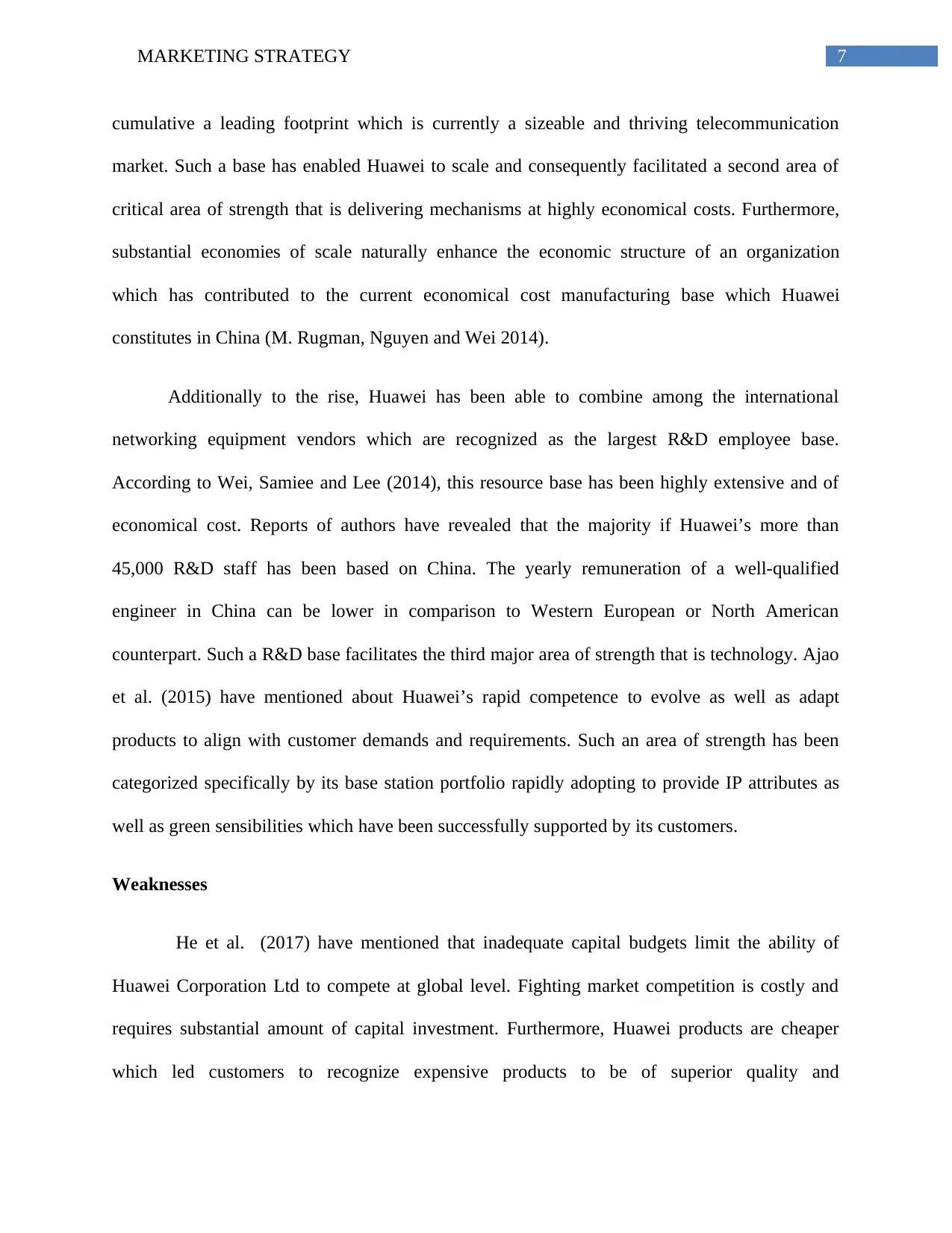
7MARKETING STRATEGY
cumulative a leading footprint which is currently a sizeable and thriving telecommunication
market. Such a base has enabled Huawei to scale and consequently facilitated a second area of
critical area of strength that is delivering mechanisms at highly economical costs. Furthermore,
substantial economies of scale naturally enhance the economic structure of an organization
which has contributed to the current economical cost manufacturing base which Huawei
constitutes in China (M. Rugman, Nguyen and Wei 2014).
Additionally to the rise, Huawei has been able to combine among the international
networking equipment vendors which are recognized as the largest R&D employee base.
According to Wei, Samiee and Lee (2014), this resource base has been highly extensive and of
economical cost. Reports of authors have revealed that the majority if Huawei’s more than
45,000 R&D staff has been based on China. The yearly remuneration of a well-qualified
engineer in China can be lower in comparison to Western European or North American
counterpart. Such a R&D base facilitates the third major area of strength that is technology. Ajao
et al. (2015) have mentioned about Huawei’s rapid competence to evolve as well as adapt
products to align with customer demands and requirements. Such an area of strength has been
categorized specifically by its base station portfolio rapidly adopting to provide IP attributes as
well as green sensibilities which have been successfully supported by its customers.
Weaknesses
He et al. (2017) have mentioned that inadequate capital budgets limit the ability of
Huawei Corporation Ltd to compete at global level. Fighting market competition is costly and
requires substantial amount of capital investment. Furthermore, Huawei products are cheaper
which led customers to recognize expensive products to be of superior quality and
cumulative a leading footprint which is currently a sizeable and thriving telecommunication
market. Such a base has enabled Huawei to scale and consequently facilitated a second area of
critical area of strength that is delivering mechanisms at highly economical costs. Furthermore,
substantial economies of scale naturally enhance the economic structure of an organization
which has contributed to the current economical cost manufacturing base which Huawei
constitutes in China (M. Rugman, Nguyen and Wei 2014).
Additionally to the rise, Huawei has been able to combine among the international
networking equipment vendors which are recognized as the largest R&D employee base.
According to Wei, Samiee and Lee (2014), this resource base has been highly extensive and of
economical cost. Reports of authors have revealed that the majority if Huawei’s more than
45,000 R&D staff has been based on China. The yearly remuneration of a well-qualified
engineer in China can be lower in comparison to Western European or North American
counterpart. Such a R&D base facilitates the third major area of strength that is technology. Ajao
et al. (2015) have mentioned about Huawei’s rapid competence to evolve as well as adapt
products to align with customer demands and requirements. Such an area of strength has been
categorized specifically by its base station portfolio rapidly adopting to provide IP attributes as
well as green sensibilities which have been successfully supported by its customers.
Weaknesses
He et al. (2017) have mentioned that inadequate capital budgets limit the ability of
Huawei Corporation Ltd to compete at global level. Fighting market competition is costly and
requires substantial amount of capital investment. Furthermore, Huawei products are cheaper
which led customers to recognize expensive products to be of superior quality and
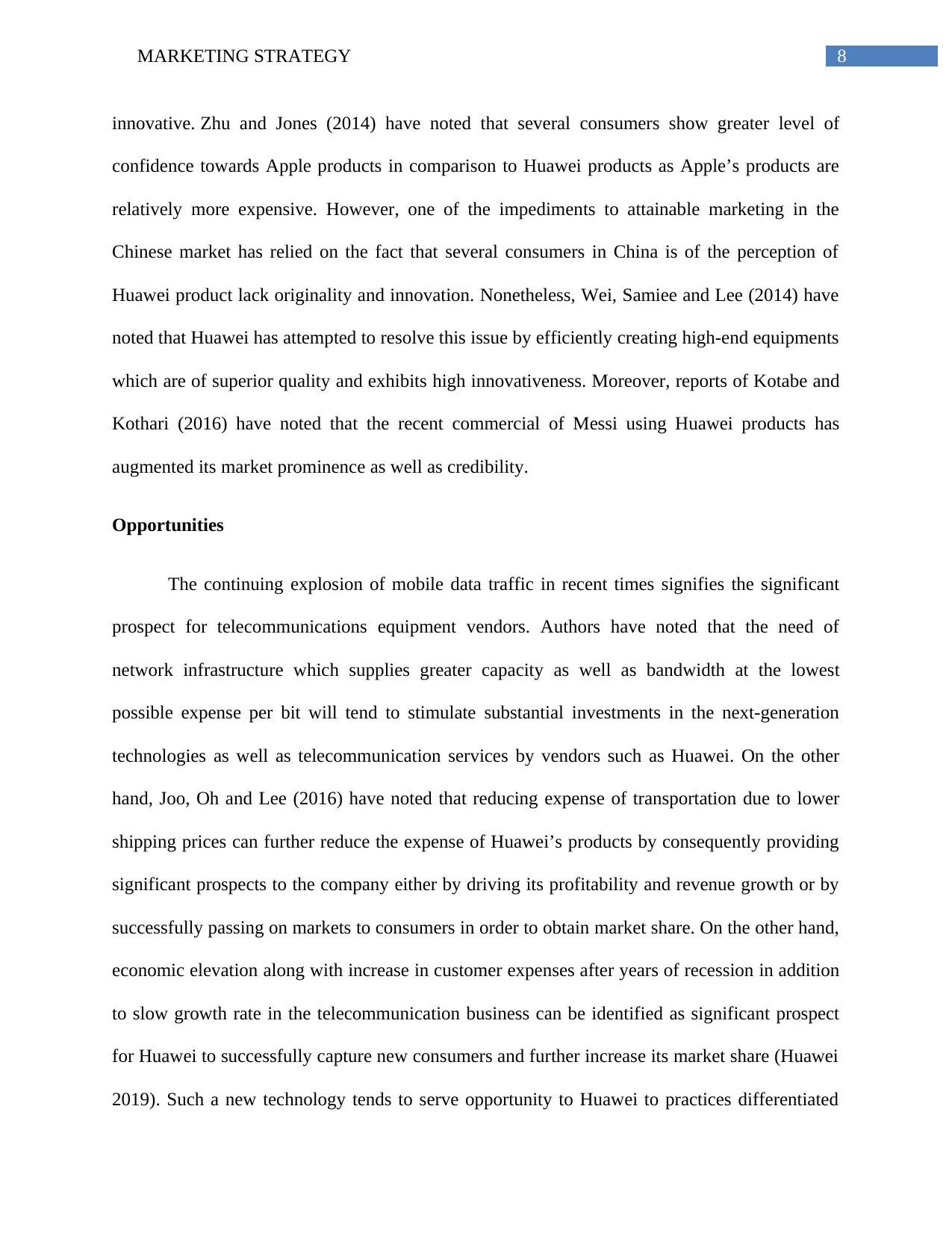
8MARKETING STRATEGY
innovative. Zhu and Jones (2014) have noted that several consumers show greater level of
confidence towards Apple products in comparison to Huawei products as Apple’s products are
relatively more expensive. However, one of the impediments to attainable marketing in the
Chinese market has relied on the fact that several consumers in China is of the perception of
Huawei product lack originality and innovation. Nonetheless, Wei, Samiee and Lee (2014) have
noted that Huawei has attempted to resolve this issue by efficiently creating high-end equipments
which are of superior quality and exhibits high innovativeness. Moreover, reports of Kotabe and
Kothari (2016) have noted that the recent commercial of Messi using Huawei products has
augmented its market prominence as well as credibility.
Opportunities
The continuing explosion of mobile data traffic in recent times signifies the significant
prospect for telecommunications equipment vendors. Authors have noted that the need of
network infrastructure which supplies greater capacity as well as bandwidth at the lowest
possible expense per bit will tend to stimulate substantial investments in the next-generation
technologies as well as telecommunication services by vendors such as Huawei. On the other
hand, Joo, Oh and Lee (2016) have noted that reducing expense of transportation due to lower
shipping prices can further reduce the expense of Huawei’s products by consequently providing
significant prospects to the company either by driving its profitability and revenue growth or by
successfully passing on markets to consumers in order to obtain market share. On the other hand,
economic elevation along with increase in customer expenses after years of recession in addition
to slow growth rate in the telecommunication business can be identified as significant prospect
for Huawei to successfully capture new consumers and further increase its market share (Huawei
2019). Such a new technology tends to serve opportunity to Huawei to practices differentiated
innovative. Zhu and Jones (2014) have noted that several consumers show greater level of
confidence towards Apple products in comparison to Huawei products as Apple’s products are
relatively more expensive. However, one of the impediments to attainable marketing in the
Chinese market has relied on the fact that several consumers in China is of the perception of
Huawei product lack originality and innovation. Nonetheless, Wei, Samiee and Lee (2014) have
noted that Huawei has attempted to resolve this issue by efficiently creating high-end equipments
which are of superior quality and exhibits high innovativeness. Moreover, reports of Kotabe and
Kothari (2016) have noted that the recent commercial of Messi using Huawei products has
augmented its market prominence as well as credibility.
Opportunities
The continuing explosion of mobile data traffic in recent times signifies the significant
prospect for telecommunications equipment vendors. Authors have noted that the need of
network infrastructure which supplies greater capacity as well as bandwidth at the lowest
possible expense per bit will tend to stimulate substantial investments in the next-generation
technologies as well as telecommunication services by vendors such as Huawei. On the other
hand, Joo, Oh and Lee (2016) have noted that reducing expense of transportation due to lower
shipping prices can further reduce the expense of Huawei’s products by consequently providing
significant prospects to the company either by driving its profitability and revenue growth or by
successfully passing on markets to consumers in order to obtain market share. On the other hand,
economic elevation along with increase in customer expenses after years of recession in addition
to slow growth rate in the telecommunication business can be identified as significant prospect
for Huawei to successfully capture new consumers and further increase its market share (Huawei
2019). Such a new technology tends to serve opportunity to Huawei to practices differentiated
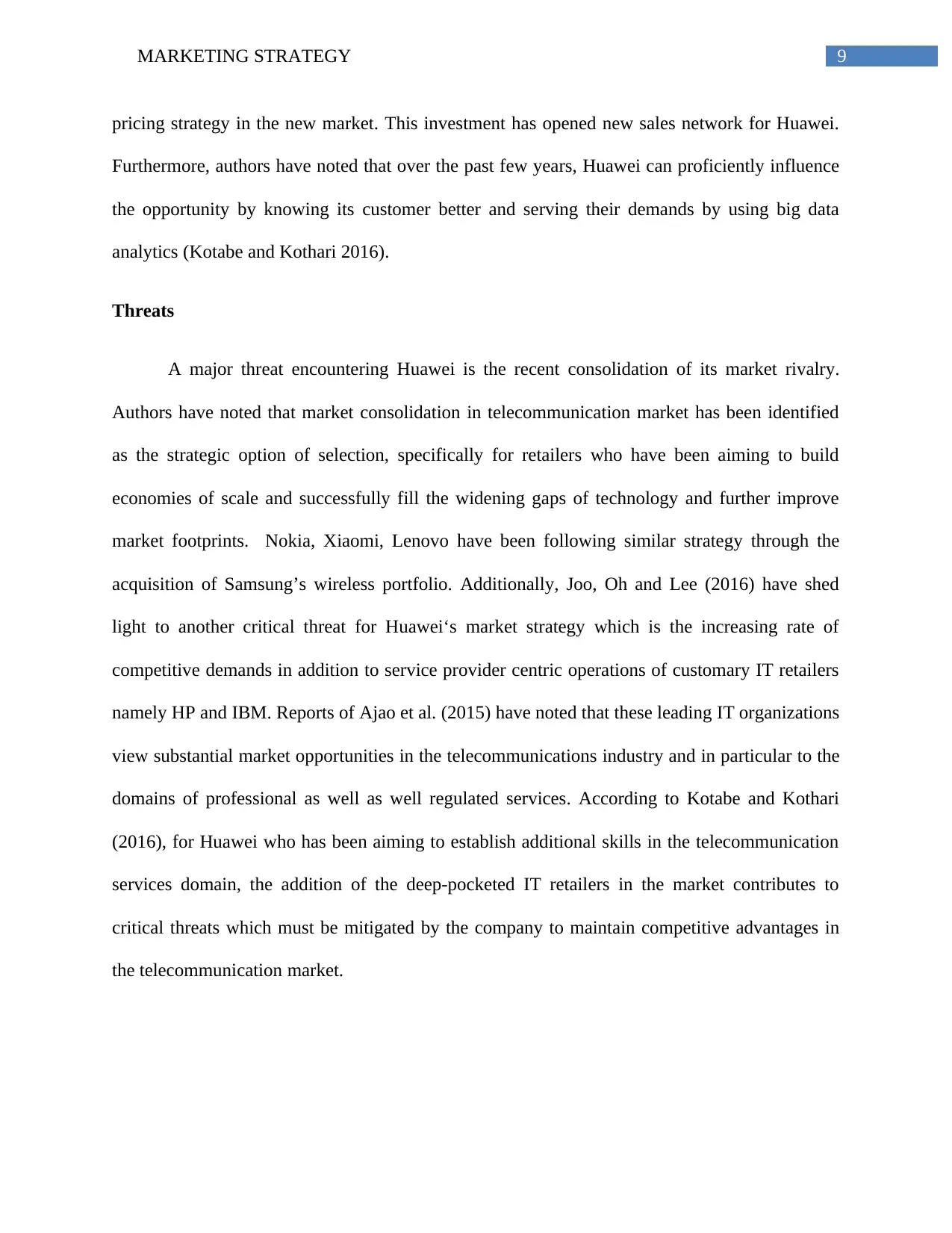
9MARKETING STRATEGY
pricing strategy in the new market. This investment has opened new sales network for Huawei.
Furthermore, authors have noted that over the past few years, Huawei can proficiently influence
the opportunity by knowing its customer better and serving their demands by using big data
analytics (Kotabe and Kothari 2016).
Threats
A major threat encountering Huawei is the recent consolidation of its market rivalry.
Authors have noted that market consolidation in telecommunication market has been identified
as the strategic option of selection, specifically for retailers who have been aiming to build
economies of scale and successfully fill the widening gaps of technology and further improve
market footprints. Nokia, Xiaomi, Lenovo have been following similar strategy through the
acquisition of Samsung’s wireless portfolio. Additionally, Joo, Oh and Lee (2016) have shed
light to another critical threat for Huawei‘s market strategy which is the increasing rate of
competitive demands in addition to service provider centric operations of customary IT retailers
namely HP and IBM. Reports of Ajao et al. (2015) have noted that these leading IT organizations
view substantial market opportunities in the telecommunications industry and in particular to the
domains of professional as well as well regulated services. According to Kotabe and Kothari
(2016), for Huawei who has been aiming to establish additional skills in the telecommunication
services domain, the addition of the deep-pocketed IT retailers in the market contributes to
critical threats which must be mitigated by the company to maintain competitive advantages in
the telecommunication market.
pricing strategy in the new market. This investment has opened new sales network for Huawei.
Furthermore, authors have noted that over the past few years, Huawei can proficiently influence
the opportunity by knowing its customer better and serving their demands by using big data
analytics (Kotabe and Kothari 2016).
Threats
A major threat encountering Huawei is the recent consolidation of its market rivalry.
Authors have noted that market consolidation in telecommunication market has been identified
as the strategic option of selection, specifically for retailers who have been aiming to build
economies of scale and successfully fill the widening gaps of technology and further improve
market footprints. Nokia, Xiaomi, Lenovo have been following similar strategy through the
acquisition of Samsung’s wireless portfolio. Additionally, Joo, Oh and Lee (2016) have shed
light to another critical threat for Huawei‘s market strategy which is the increasing rate of
competitive demands in addition to service provider centric operations of customary IT retailers
namely HP and IBM. Reports of Ajao et al. (2015) have noted that these leading IT organizations
view substantial market opportunities in the telecommunications industry and in particular to the
domains of professional as well as well regulated services. According to Kotabe and Kothari
(2016), for Huawei who has been aiming to establish additional skills in the telecommunication
services domain, the addition of the deep-pocketed IT retailers in the market contributes to
critical threats which must be mitigated by the company to maintain competitive advantages in
the telecommunication market.
Secure Best Marks with AI Grader
Need help grading? Try our AI Grader for instant feedback on your assignments.
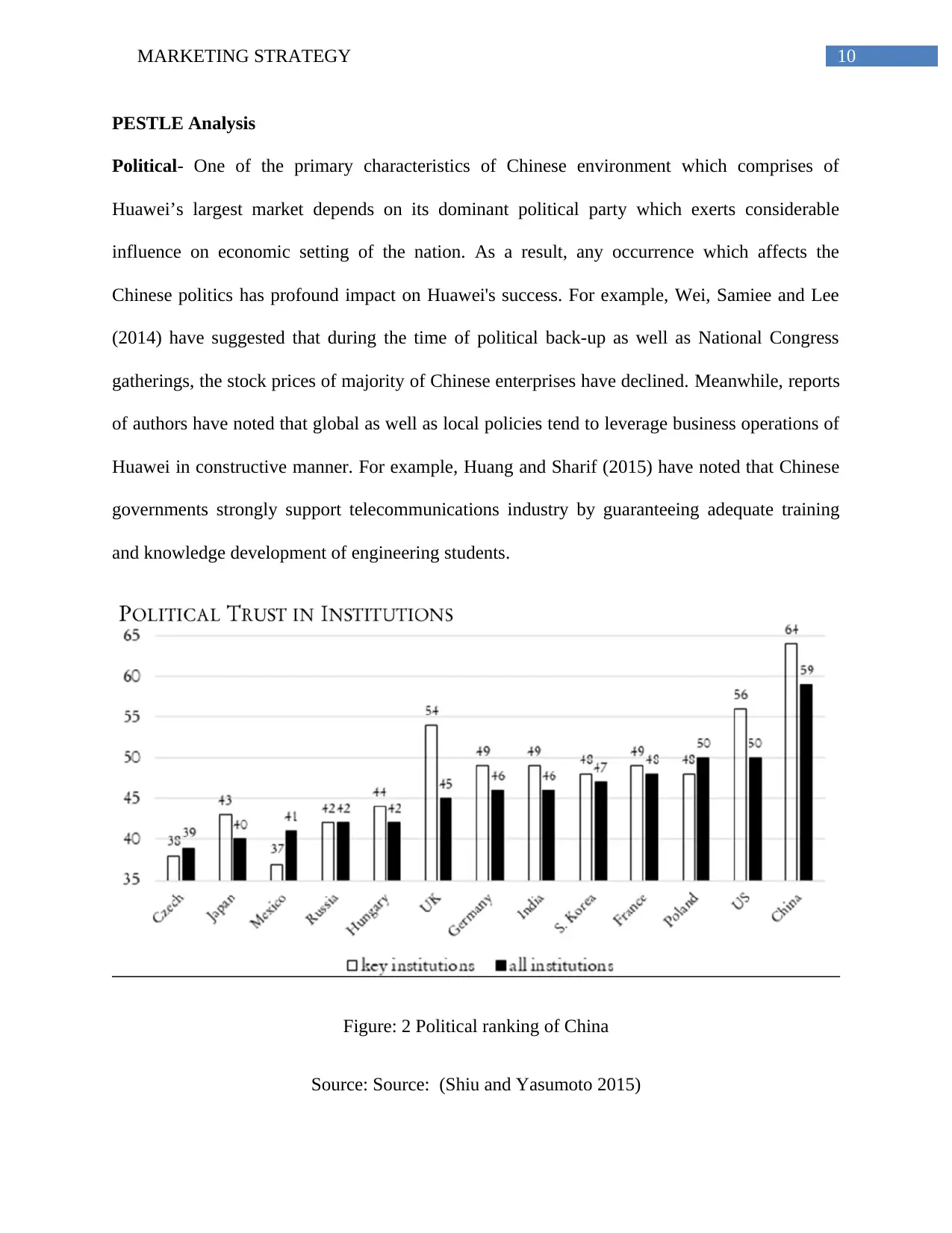
10MARKETING STRATEGY
PESTLE Analysis
Political- One of the primary characteristics of Chinese environment which comprises of
Huawei’s largest market depends on its dominant political party which exerts considerable
influence on economic setting of the nation. As a result, any occurrence which affects the
Chinese politics has profound impact on Huawei's success. For example, Wei, Samiee and Lee
(2014) have suggested that during the time of political back-up as well as National Congress
gatherings, the stock prices of majority of Chinese enterprises have declined. Meanwhile, reports
of authors have noted that global as well as local policies tend to leverage business operations of
Huawei in constructive manner. For example, Huang and Sharif (2015) have noted that Chinese
governments strongly support telecommunications industry by guaranteeing adequate training
and knowledge development of engineering students.
Figure: 2 Political ranking of China
Source: Source: (Shiu and Yasumoto 2015)
PESTLE Analysis
Political- One of the primary characteristics of Chinese environment which comprises of
Huawei’s largest market depends on its dominant political party which exerts considerable
influence on economic setting of the nation. As a result, any occurrence which affects the
Chinese politics has profound impact on Huawei's success. For example, Wei, Samiee and Lee
(2014) have suggested that during the time of political back-up as well as National Congress
gatherings, the stock prices of majority of Chinese enterprises have declined. Meanwhile, reports
of authors have noted that global as well as local policies tend to leverage business operations of
Huawei in constructive manner. For example, Huang and Sharif (2015) have noted that Chinese
governments strongly support telecommunications industry by guaranteeing adequate training
and knowledge development of engineering students.
Figure: 2 Political ranking of China
Source: Source: (Shiu and Yasumoto 2015)
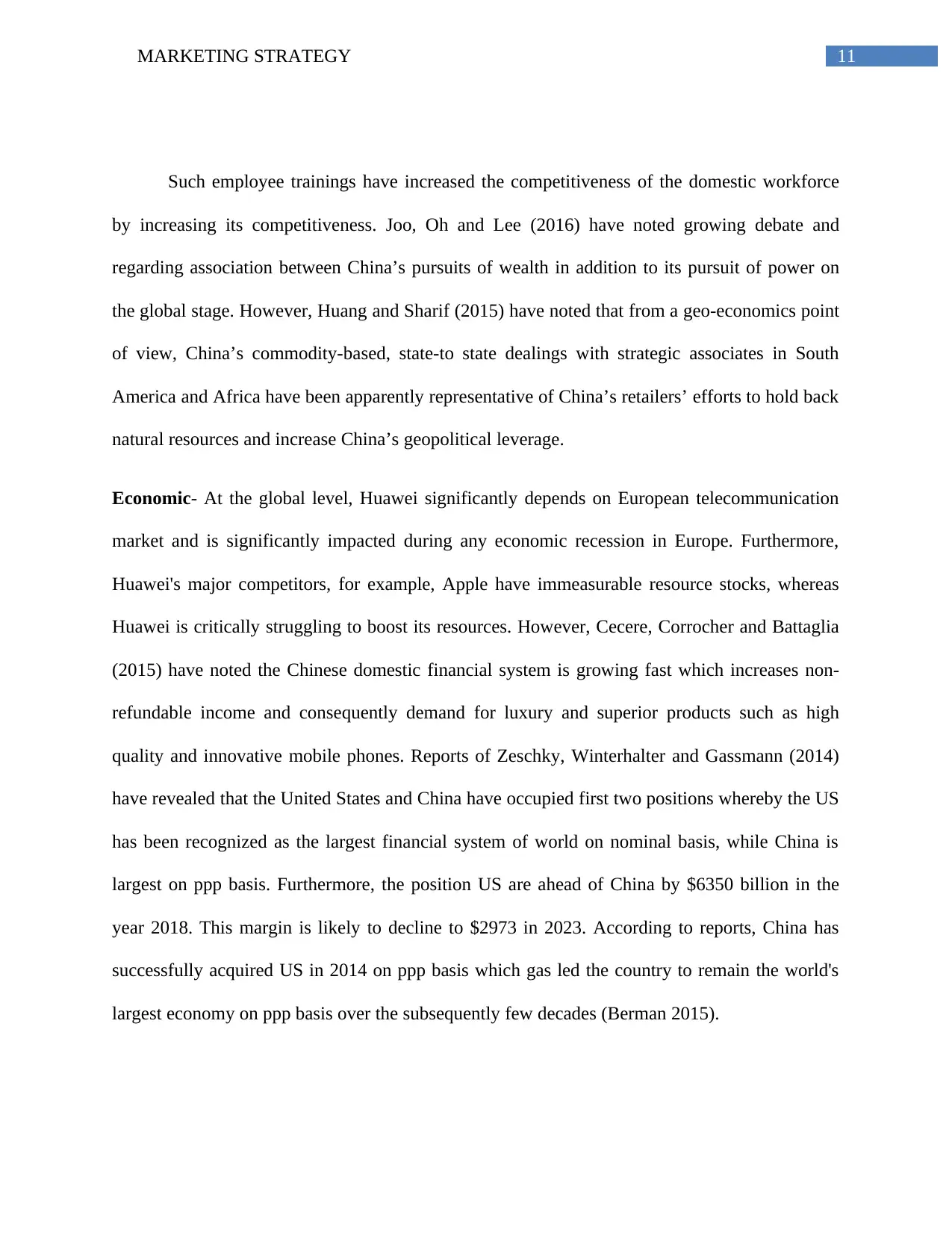
11MARKETING STRATEGY
Such employee trainings have increased the competitiveness of the domestic workforce
by increasing its competitiveness. Joo, Oh and Lee (2016) have noted growing debate and
regarding association between China’s pursuits of wealth in addition to its pursuit of power on
the global stage. However, Huang and Sharif (2015) have noted that from a geo-economics point
of view, China’s commodity-based, state-to state dealings with strategic associates in South
America and Africa have been apparently representative of China’s retailers’ efforts to hold back
natural resources and increase China’s geopolitical leverage.
Economic- At the global level, Huawei significantly depends on European telecommunication
market and is significantly impacted during any economic recession in Europe. Furthermore,
Huawei's major competitors, for example, Apple have immeasurable resource stocks, whereas
Huawei is critically struggling to boost its resources. However, Cecere, Corrocher and Battaglia
(2015) have noted the Chinese domestic financial system is growing fast which increases non-
refundable income and consequently demand for luxury and superior products such as high
quality and innovative mobile phones. Reports of Zeschky, Winterhalter and Gassmann (2014)
have revealed that the United States and China have occupied first two positions whereby the US
has been recognized as the largest financial system of world on nominal basis, while China is
largest on ppp basis. Furthermore, the position US are ahead of China by $6350 billion in the
year 2018. This margin is likely to decline to $2973 in 2023. According to reports, China has
successfully acquired US in 2014 on ppp basis which gas led the country to remain the world's
largest economy on ppp basis over the subsequently few decades (Berman 2015).
Such employee trainings have increased the competitiveness of the domestic workforce
by increasing its competitiveness. Joo, Oh and Lee (2016) have noted growing debate and
regarding association between China’s pursuits of wealth in addition to its pursuit of power on
the global stage. However, Huang and Sharif (2015) have noted that from a geo-economics point
of view, China’s commodity-based, state-to state dealings with strategic associates in South
America and Africa have been apparently representative of China’s retailers’ efforts to hold back
natural resources and increase China’s geopolitical leverage.
Economic- At the global level, Huawei significantly depends on European telecommunication
market and is significantly impacted during any economic recession in Europe. Furthermore,
Huawei's major competitors, for example, Apple have immeasurable resource stocks, whereas
Huawei is critically struggling to boost its resources. However, Cecere, Corrocher and Battaglia
(2015) have noted the Chinese domestic financial system is growing fast which increases non-
refundable income and consequently demand for luxury and superior products such as high
quality and innovative mobile phones. Reports of Zeschky, Winterhalter and Gassmann (2014)
have revealed that the United States and China have occupied first two positions whereby the US
has been recognized as the largest financial system of world on nominal basis, while China is
largest on ppp basis. Furthermore, the position US are ahead of China by $6350 billion in the
year 2018. This margin is likely to decline to $2973 in 2023. According to reports, China has
successfully acquired US in 2014 on ppp basis which gas led the country to remain the world's
largest economy on ppp basis over the subsequently few decades (Berman 2015).
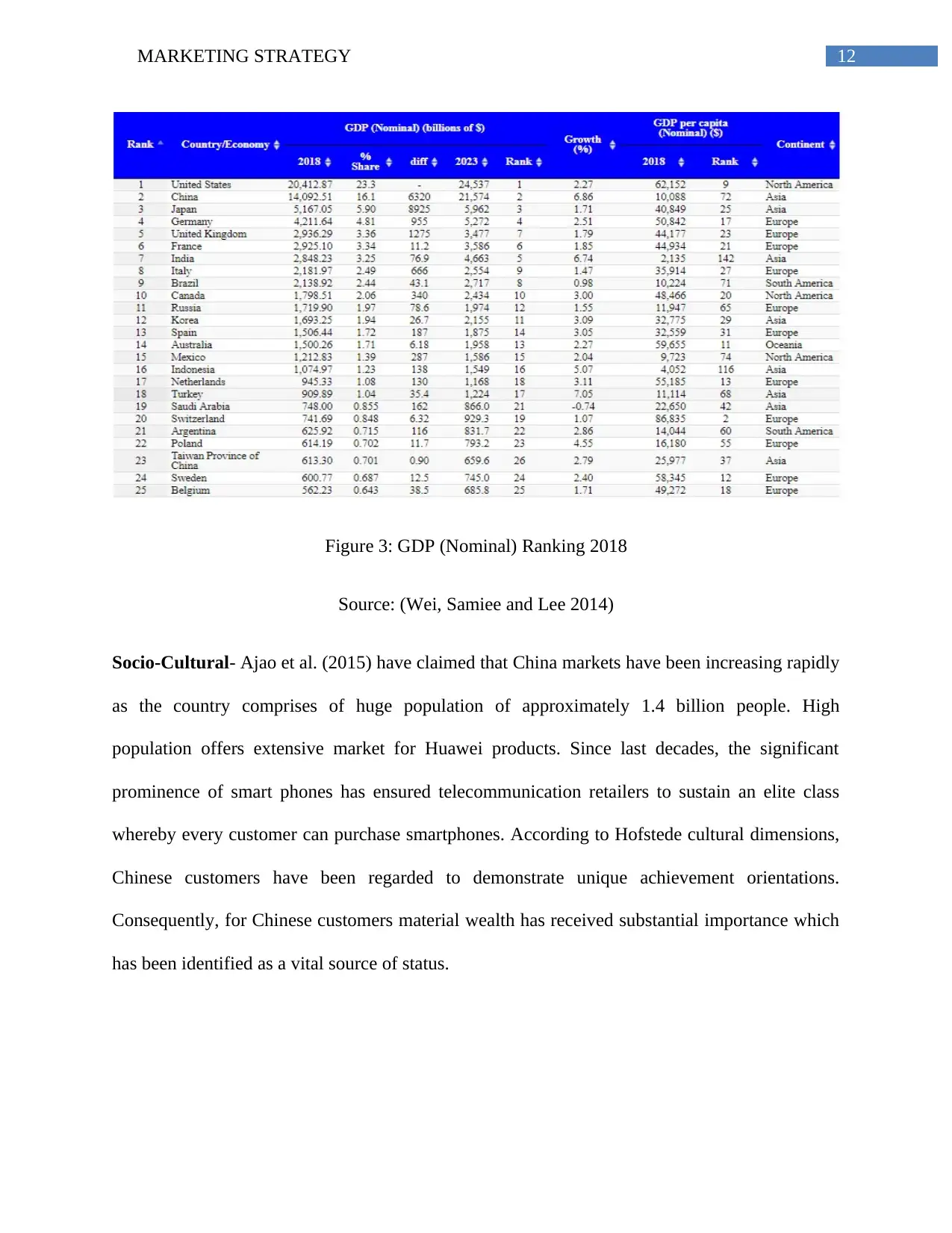
12MARKETING STRATEGY
Figure 3: GDP (Nominal) Ranking 2018
Source: (Wei, Samiee and Lee 2014)
Socio-Cultural- Ajao et al. (2015) have claimed that China markets have been increasing rapidly
as the country comprises of huge population of approximately 1.4 billion people. High
population offers extensive market for Huawei products. Since last decades, the significant
prominence of smart phones has ensured telecommunication retailers to sustain an elite class
whereby every customer can purchase smartphones. According to Hofstede cultural dimensions,
Chinese customers have been regarded to demonstrate unique achievement orientations.
Consequently, for Chinese customers material wealth has received substantial importance which
has been identified as a vital source of status.
Figure 3: GDP (Nominal) Ranking 2018
Source: (Wei, Samiee and Lee 2014)
Socio-Cultural- Ajao et al. (2015) have claimed that China markets have been increasing rapidly
as the country comprises of huge population of approximately 1.4 billion people. High
population offers extensive market for Huawei products. Since last decades, the significant
prominence of smart phones has ensured telecommunication retailers to sustain an elite class
whereby every customer can purchase smartphones. According to Hofstede cultural dimensions,
Chinese customers have been regarded to demonstrate unique achievement orientations.
Consequently, for Chinese customers material wealth has received substantial importance which
has been identified as a vital source of status.
Paraphrase This Document
Need a fresh take? Get an instant paraphrase of this document with our AI Paraphraser
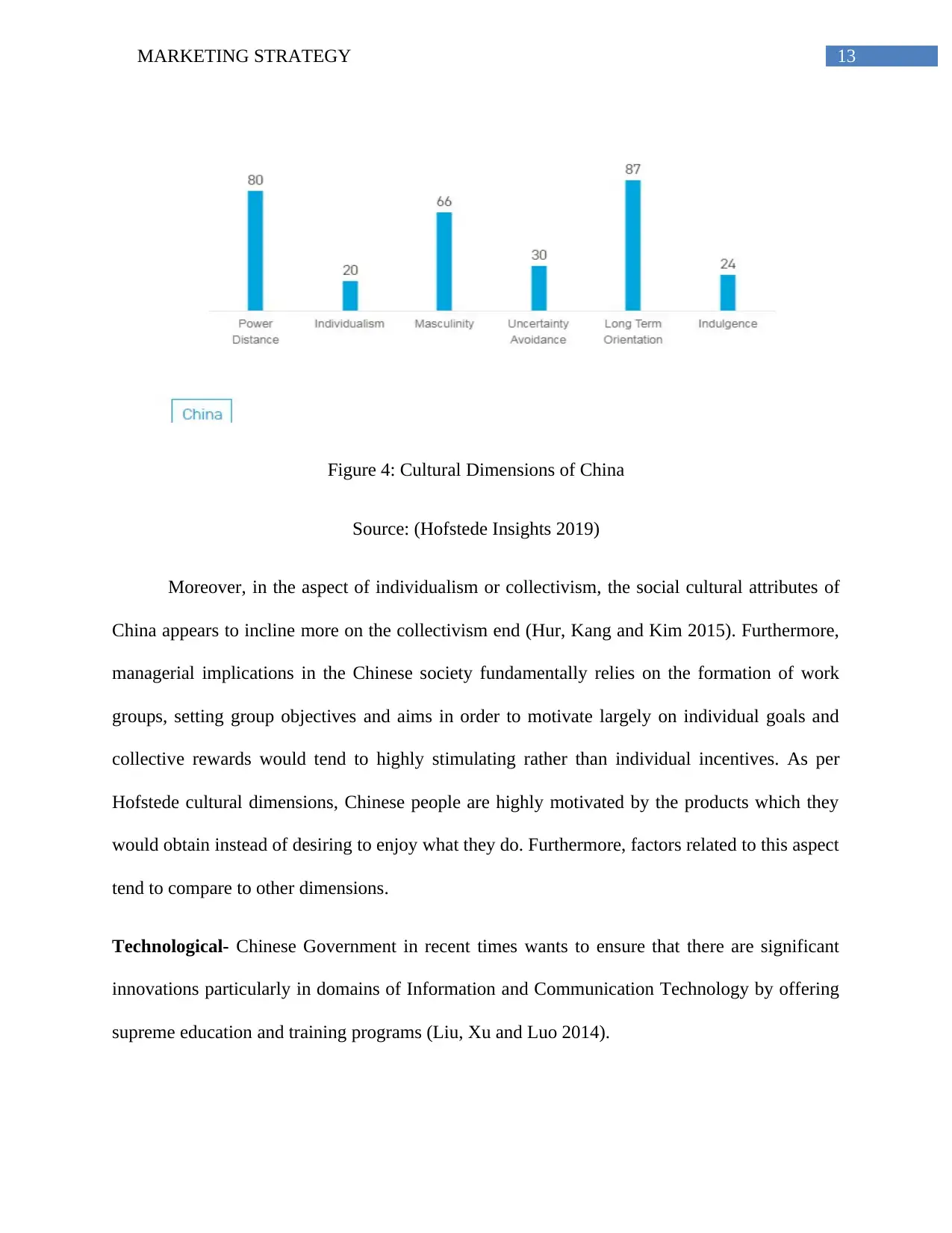
13MARKETING STRATEGY
Figure 4: Cultural Dimensions of China
Source: (Hofstede Insights 2019)
Moreover, in the aspect of individualism or collectivism, the social cultural attributes of
China appears to incline more on the collectivism end (Hur, Kang and Kim 2015). Furthermore,
managerial implications in the Chinese society fundamentally relies on the formation of work
groups, setting group objectives and aims in order to motivate largely on individual goals and
collective rewards would tend to highly stimulating rather than individual incentives. As per
Hofstede cultural dimensions, Chinese people are highly motivated by the products which they
would obtain instead of desiring to enjoy what they do. Furthermore, factors related to this aspect
tend to compare to other dimensions.
Technological- Chinese Government in recent times wants to ensure that there are significant
innovations particularly in domains of Information and Communication Technology by offering
supreme education and training programs (Liu, Xu and Luo 2014).
Figure 4: Cultural Dimensions of China
Source: (Hofstede Insights 2019)
Moreover, in the aspect of individualism or collectivism, the social cultural attributes of
China appears to incline more on the collectivism end (Hur, Kang and Kim 2015). Furthermore,
managerial implications in the Chinese society fundamentally relies on the formation of work
groups, setting group objectives and aims in order to motivate largely on individual goals and
collective rewards would tend to highly stimulating rather than individual incentives. As per
Hofstede cultural dimensions, Chinese people are highly motivated by the products which they
would obtain instead of desiring to enjoy what they do. Furthermore, factors related to this aspect
tend to compare to other dimensions.
Technological- Chinese Government in recent times wants to ensure that there are significant
innovations particularly in domains of Information and Communication Technology by offering
supreme education and training programs (Liu, Xu and Luo 2014).

14MARKETING STRATEGY
Figure 5: China’s ranking in Technology
Source: (Shiu and Yasumoto 2015)
Environmental- Chu (2017) has noted that the Green pipe of Huawei has comprised of
environmental regulations which must be adhered by the company in order to safeguard the
business environment. Comprehensive studies of Cordova-Pizarro et al. (2019) have mentioned
that wastes of the company are reutilized to reduce potential wastages and further to maximise
attainable materials.
Figure 5: China’s ranking in Technology
Source: (Shiu and Yasumoto 2015)
Environmental- Chu (2017) has noted that the Green pipe of Huawei has comprised of
environmental regulations which must be adhered by the company in order to safeguard the
business environment. Comprehensive studies of Cordova-Pizarro et al. (2019) have mentioned
that wastes of the company are reutilized to reduce potential wastages and further to maximise
attainable materials.
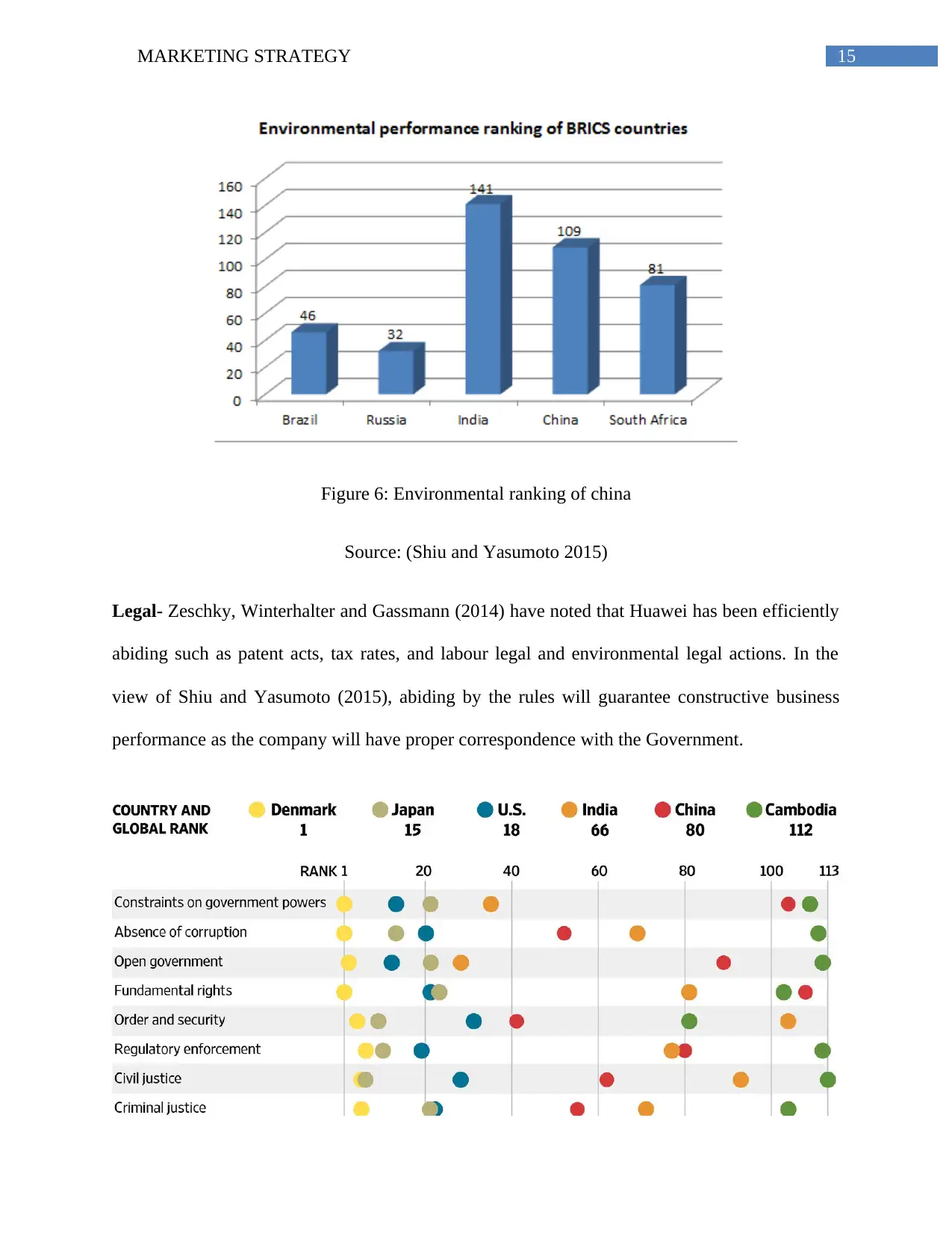
15MARKETING STRATEGY
Figure 6: Environmental ranking of china
Source: (Shiu and Yasumoto 2015)
Legal- Zeschky, Winterhalter and Gassmann (2014) have noted that Huawei has been efficiently
abiding such as patent acts, tax rates, and labour legal and environmental legal actions. In the
view of Shiu and Yasumoto (2015), abiding by the rules will guarantee constructive business
performance as the company will have proper correspondence with the Government.
Figure 6: Environmental ranking of china
Source: (Shiu and Yasumoto 2015)
Legal- Zeschky, Winterhalter and Gassmann (2014) have noted that Huawei has been efficiently
abiding such as patent acts, tax rates, and labour legal and environmental legal actions. In the
view of Shiu and Yasumoto (2015), abiding by the rules will guarantee constructive business
performance as the company will have proper correspondence with the Government.
Secure Best Marks with AI Grader
Need help grading? Try our AI Grader for instant feedback on your assignments.
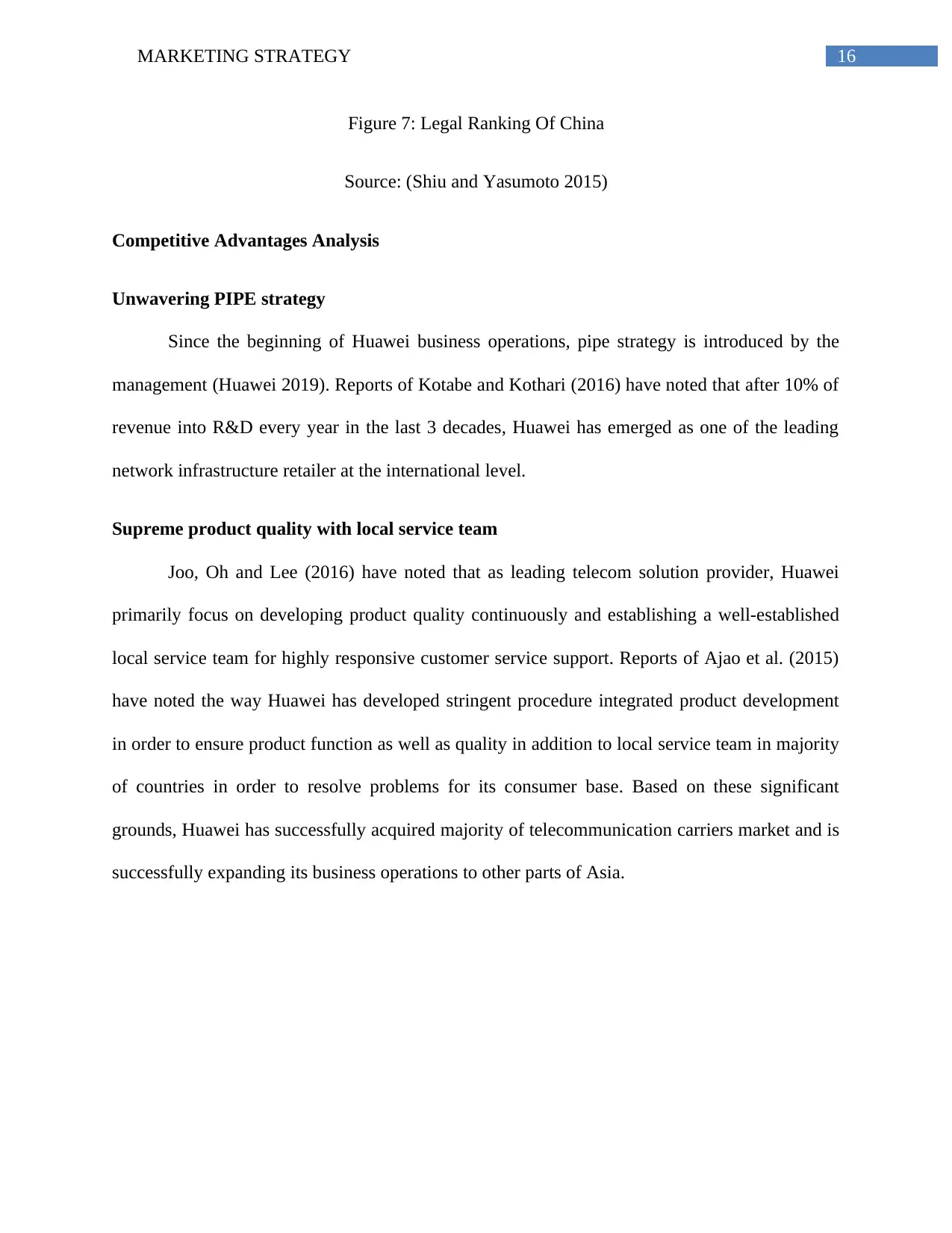
16MARKETING STRATEGY
Figure 7: Legal Ranking Of China
Source: (Shiu and Yasumoto 2015)
Competitive Advantages Analysis
Unwavering PIPE strategy
Since the beginning of Huawei business operations, pipe strategy is introduced by the
management (Huawei 2019). Reports of Kotabe and Kothari (2016) have noted that after 10% of
revenue into R&D every year in the last 3 decades, Huawei has emerged as one of the leading
network infrastructure retailer at the international level.
Supreme product quality with local service team
Joo, Oh and Lee (2016) have noted that as leading telecom solution provider, Huawei
primarily focus on developing product quality continuously and establishing a well-established
local service team for highly responsive customer service support. Reports of Ajao et al. (2015)
have noted the way Huawei has developed stringent procedure integrated product development
in order to ensure product function as well as quality in addition to local service team in majority
of countries in order to resolve problems for its consumer base. Based on these significant
grounds, Huawei has successfully acquired majority of telecommunication carriers market and is
successfully expanding its business operations to other parts of Asia.
Figure 7: Legal Ranking Of China
Source: (Shiu and Yasumoto 2015)
Competitive Advantages Analysis
Unwavering PIPE strategy
Since the beginning of Huawei business operations, pipe strategy is introduced by the
management (Huawei 2019). Reports of Kotabe and Kothari (2016) have noted that after 10% of
revenue into R&D every year in the last 3 decades, Huawei has emerged as one of the leading
network infrastructure retailer at the international level.
Supreme product quality with local service team
Joo, Oh and Lee (2016) have noted that as leading telecom solution provider, Huawei
primarily focus on developing product quality continuously and establishing a well-established
local service team for highly responsive customer service support. Reports of Ajao et al. (2015)
have noted the way Huawei has developed stringent procedure integrated product development
in order to ensure product function as well as quality in addition to local service team in majority
of countries in order to resolve problems for its consumer base. Based on these significant
grounds, Huawei has successfully acquired majority of telecommunication carriers market and is
successfully expanding its business operations to other parts of Asia.

17MARKETING STRATEGY
Apple
High price
Low
Samsung Xiaomi
Huawei
Nokia
Low Quality
High
Samsung
Nokia
Figure 8 : Perceptual Map
Source: Created by author
Competitive profile Matrix
Samsung Hauwei Xiaome
Critical
Success
factor
weight Rating 1-
4
Weighted
Score
Rating 1-
4
Weighted
Score
Rating 1-
4
Weighted
Score
Service
Quality
2 2 4 3 6 3 6
Customer
Loyalty
3 3 9 4 12 2 6
Technologica 3 3 9 4 12 3 9
Apple
High price
Low
Samsung Xiaomi
Huawei
Nokia
Low Quality
High
Samsung
Nokia
Figure 8 : Perceptual Map
Source: Created by author
Competitive profile Matrix
Samsung Hauwei Xiaome
Critical
Success
factor
weight Rating 1-
4
Weighted
Score
Rating 1-
4
Weighted
Score
Rating 1-
4
Weighted
Score
Service
Quality
2 2 4 3 6 3 6
Customer
Loyalty
3 3 9 4 12 2 6
Technologica 3 3 9 4 12 3 9
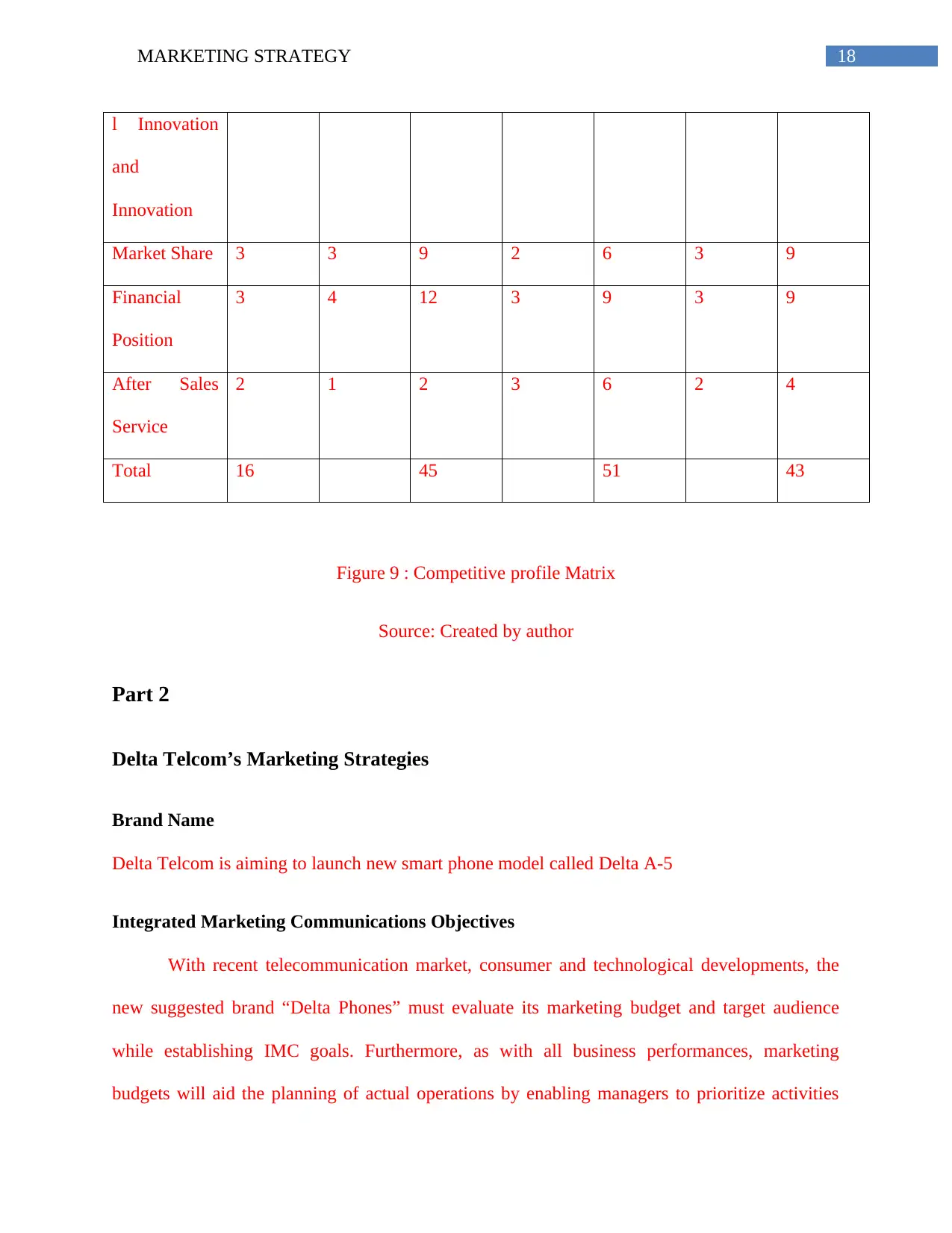
18MARKETING STRATEGY
l Innovation
and
Innovation
Market Share 3 3 9 2 6 3 9
Financial
Position
3 4 12 3 9 3 9
After Sales
Service
2 1 2 3 6 2 4
Total 16 45 51 43
Figure 9 : Competitive profile Matrix
Source: Created by author
Part 2
Delta Telcom’s Marketing Strategies
Brand Name
Delta Telcom is aiming to launch new smart phone model called Delta A-5
Integrated Marketing Communications Objectives
With recent telecommunication market, consumer and technological developments, the
new suggested brand “Delta Phones” must evaluate its marketing budget and target audience
while establishing IMC goals. Furthermore, as with all business performances, marketing
budgets will aid the planning of actual operations by enabling managers to prioritize activities
l Innovation
and
Innovation
Market Share 3 3 9 2 6 3 9
Financial
Position
3 4 12 3 9 3 9
After Sales
Service
2 1 2 3 6 2 4
Total 16 45 51 43
Figure 9 : Competitive profile Matrix
Source: Created by author
Part 2
Delta Telcom’s Marketing Strategies
Brand Name
Delta Telcom is aiming to launch new smart phone model called Delta A-5
Integrated Marketing Communications Objectives
With recent telecommunication market, consumer and technological developments, the
new suggested brand “Delta Phones” must evaluate its marketing budget and target audience
while establishing IMC goals. Furthermore, as with all business performances, marketing
budgets will aid the planning of actual operations by enabling managers to prioritize activities
Paraphrase This Document
Need a fresh take? Get an instant paraphrase of this document with our AI Paraphraser
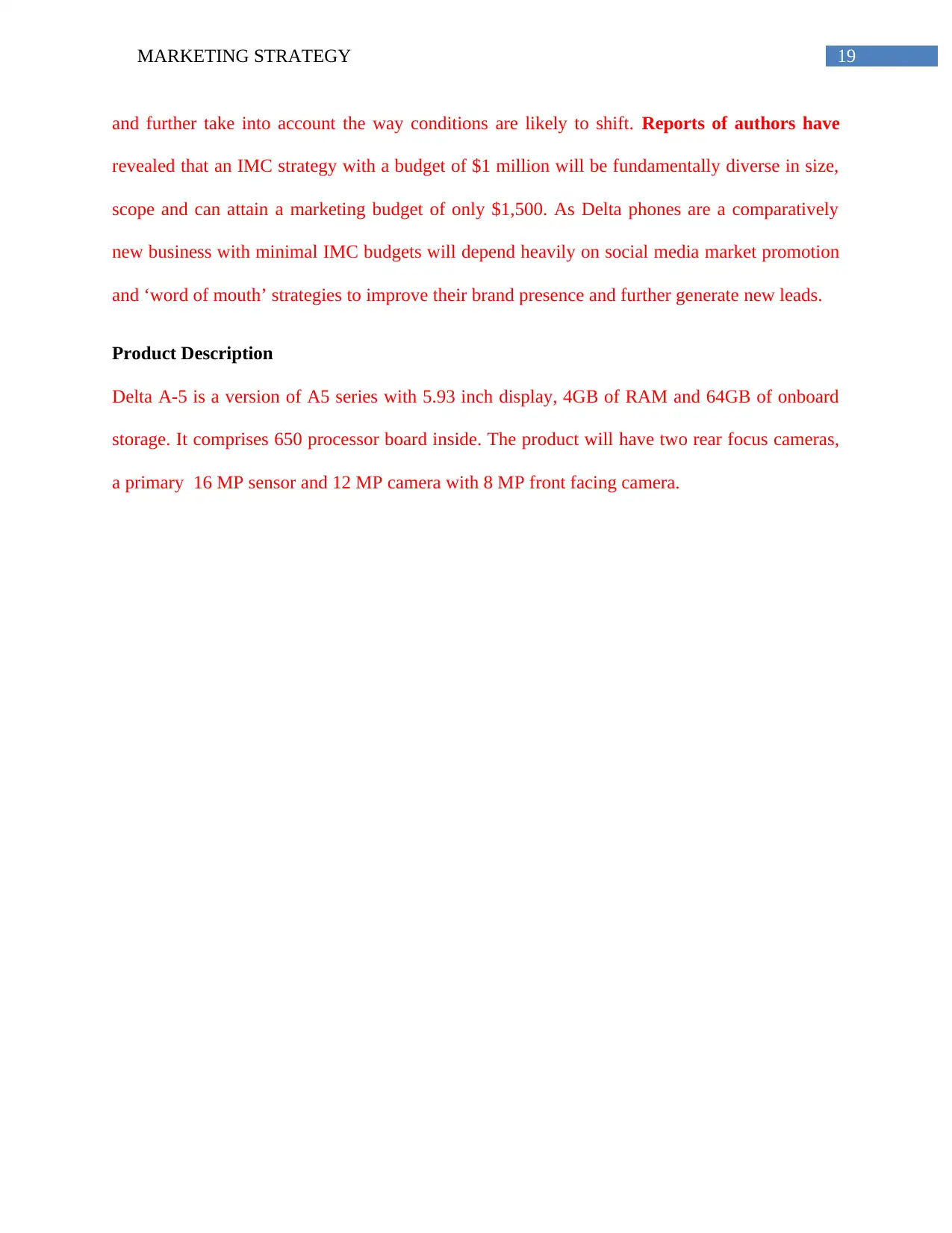
19MARKETING STRATEGY
and further take into account the way conditions are likely to shift. Reports of authors have
revealed that an IMC strategy with a budget of $1 million will be fundamentally diverse in size,
scope and can attain a marketing budget of only $1,500. As Delta phones are a comparatively
new business with minimal IMC budgets will depend heavily on social media market promotion
and ‘word of mouth’ strategies to improve their brand presence and further generate new leads.
Product Description
Delta A-5 is a version of A5 series with 5.93 inch display, 4GB of RAM and 64GB of onboard
storage. It comprises 650 processor board inside. The product will have two rear focus cameras,
a primary 16 MP sensor and 12 MP camera with 8 MP front facing camera.
and further take into account the way conditions are likely to shift. Reports of authors have
revealed that an IMC strategy with a budget of $1 million will be fundamentally diverse in size,
scope and can attain a marketing budget of only $1,500. As Delta phones are a comparatively
new business with minimal IMC budgets will depend heavily on social media market promotion
and ‘word of mouth’ strategies to improve their brand presence and further generate new leads.
Product Description
Delta A-5 is a version of A5 series with 5.93 inch display, 4GB of RAM and 64GB of onboard
storage. It comprises 650 processor board inside. The product will have two rear focus cameras,
a primary 16 MP sensor and 12 MP camera with 8 MP front facing camera.
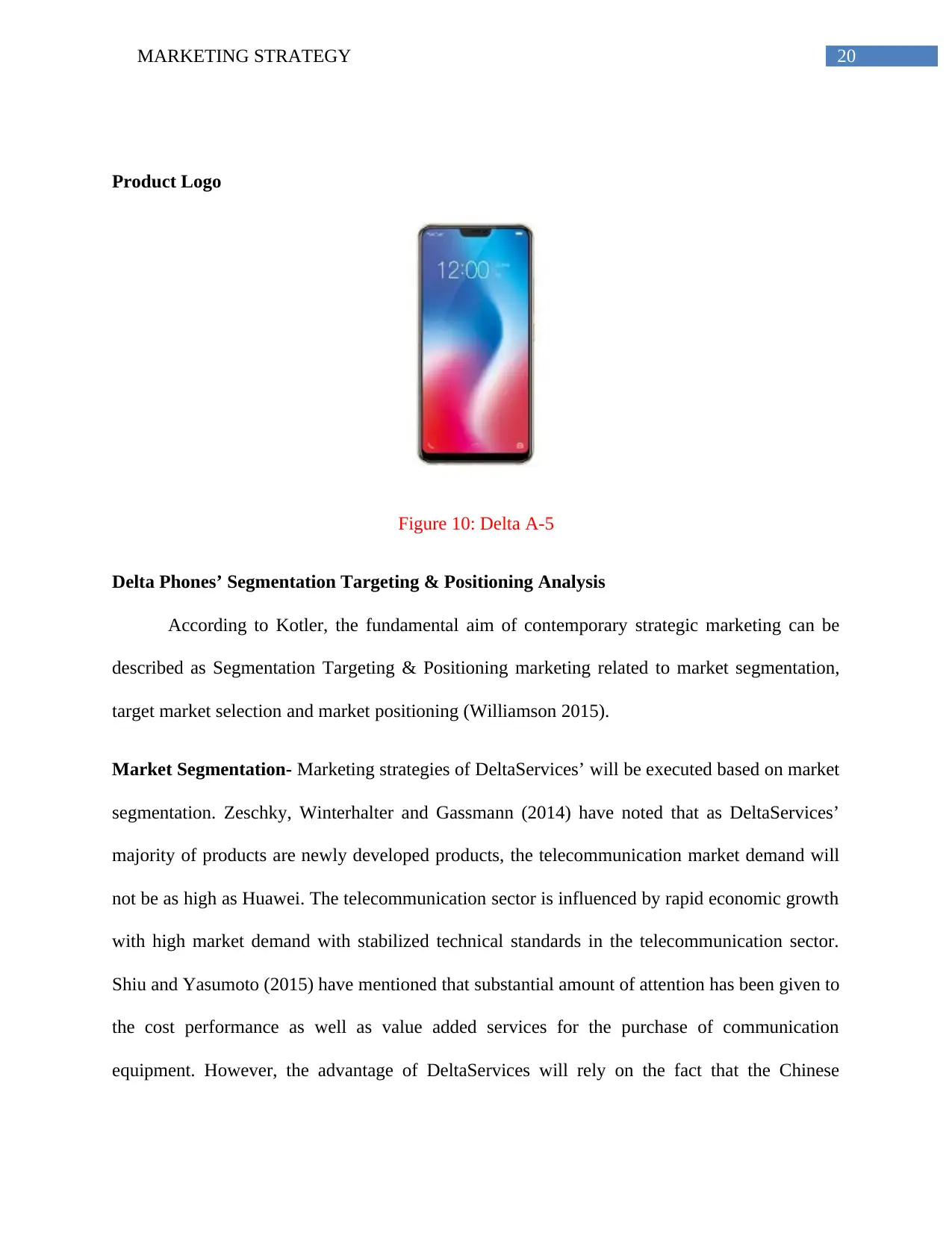
20MARKETING STRATEGY
Product Logo
Figure 10: Delta A-5
Delta Phones’ Segmentation Targeting & Positioning Analysis
According to Kotler, the fundamental aim of contemporary strategic marketing can be
described as Segmentation Targeting & Positioning marketing related to market segmentation,
target market selection and market positioning (Williamson 2015).
Market Segmentation- Marketing strategies of DeltaServices’ will be executed based on market
segmentation. Zeschky, Winterhalter and Gassmann (2014) have noted that as DeltaServices’
majority of products are newly developed products, the telecommunication market demand will
not be as high as Huawei. The telecommunication sector is influenced by rapid economic growth
with high market demand with stabilized technical standards in the telecommunication sector.
Shiu and Yasumoto (2015) have mentioned that substantial amount of attention has been given to
the cost performance as well as value added services for the purchase of communication
equipment. However, the advantage of DeltaServices will rely on the fact that the Chinese
Product Logo
Figure 10: Delta A-5
Delta Phones’ Segmentation Targeting & Positioning Analysis
According to Kotler, the fundamental aim of contemporary strategic marketing can be
described as Segmentation Targeting & Positioning marketing related to market segmentation,
target market selection and market positioning (Williamson 2015).
Market Segmentation- Marketing strategies of DeltaServices’ will be executed based on market
segmentation. Zeschky, Winterhalter and Gassmann (2014) have noted that as DeltaServices’
majority of products are newly developed products, the telecommunication market demand will
not be as high as Huawei. The telecommunication sector is influenced by rapid economic growth
with high market demand with stabilized technical standards in the telecommunication sector.
Shiu and Yasumoto (2015) have mentioned that substantial amount of attention has been given to
the cost performance as well as value added services for the purchase of communication
equipment. However, the advantage of DeltaServices will rely on the fact that the Chinese
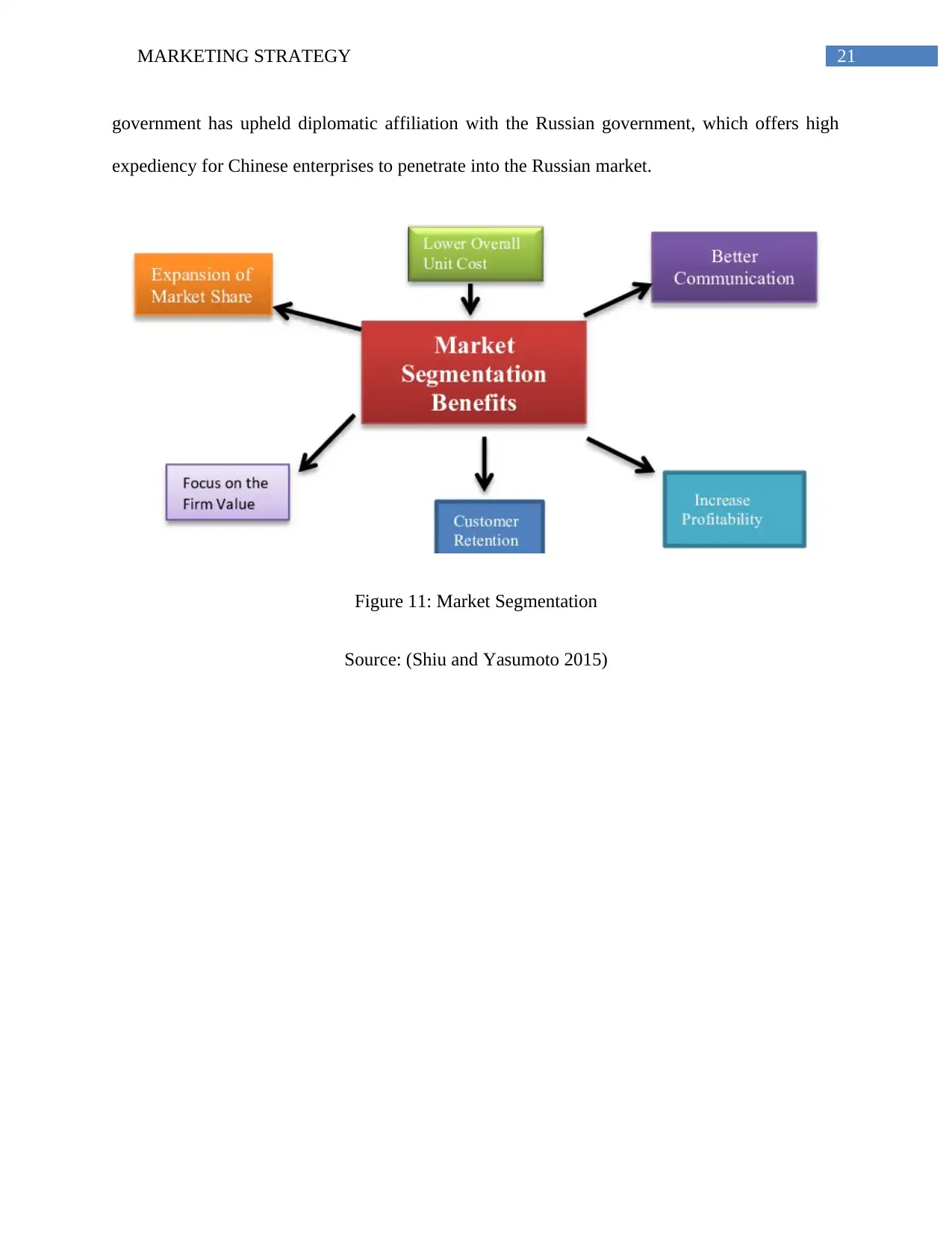
21MARKETING STRATEGY
government has upheld diplomatic affiliation with the Russian government, which offers high
expediency for Chinese enterprises to penetrate into the Russian market.
Figure 11: Market Segmentation
Source: (Shiu and Yasumoto 2015)
government has upheld diplomatic affiliation with the Russian government, which offers high
expediency for Chinese enterprises to penetrate into the Russian market.
Figure 11: Market Segmentation
Source: (Shiu and Yasumoto 2015)
Secure Best Marks with AI Grader
Need help grading? Try our AI Grader for instant feedback on your assignments.
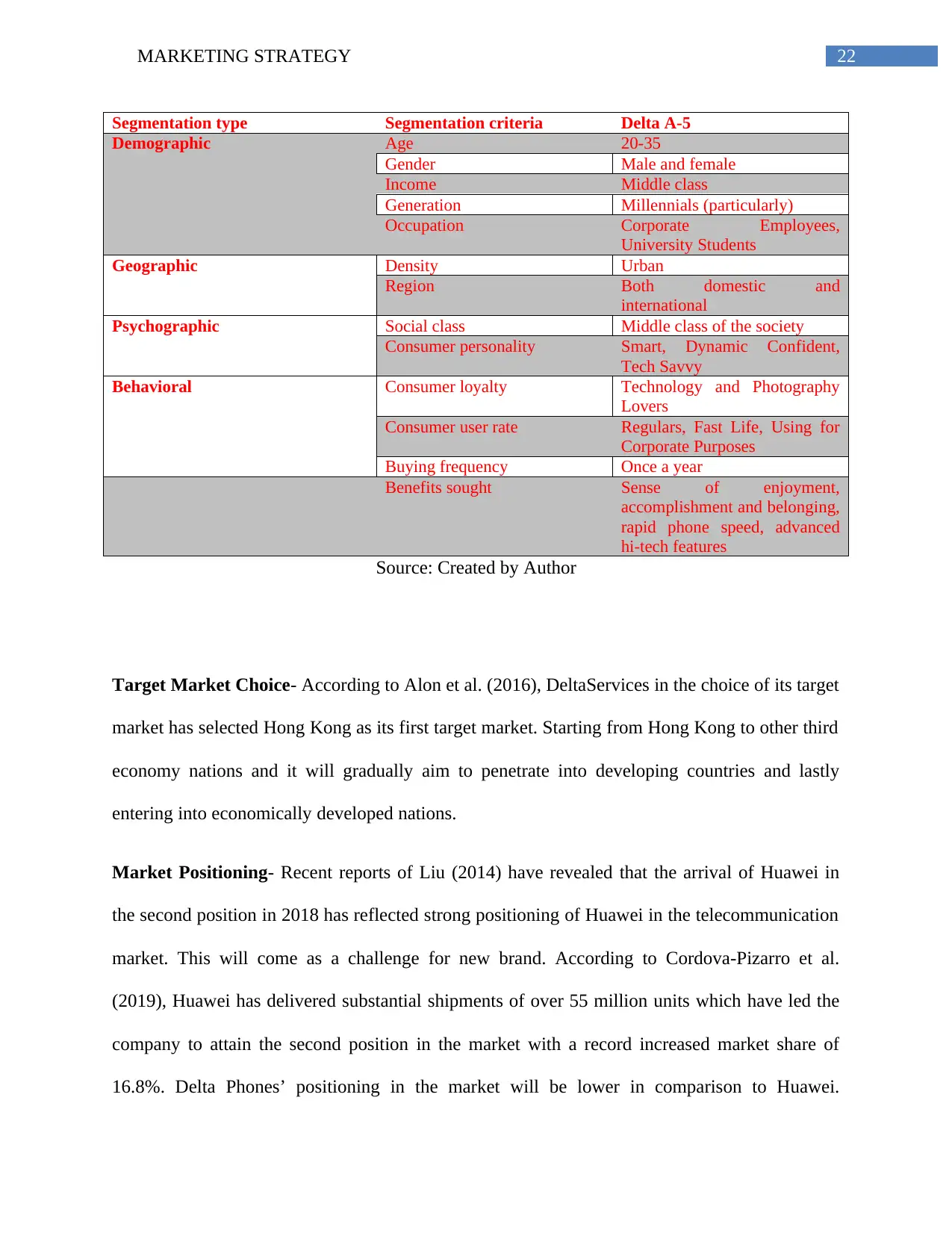
22MARKETING STRATEGY
Segmentation type Segmentation criteria Delta A-5
Demographic Age 20-35
Gender Male and female
Income Middle class
Generation Millennials (particularly)
Occupation Corporate Employees,
University Students
Geographic Density Urban
Region Both domestic and
international
Psychographic Social class Middle class of the society
Consumer personality Smart, Dynamic Confident,
Tech Savvy
Behavioral Consumer loyalty Technology and Photography
Lovers
Consumer user rate Regulars, Fast Life, Using for
Corporate Purposes
Buying frequency Once a year
Benefits sought Sense of enjoyment,
accomplishment and belonging,
rapid phone speed, advanced
hi-tech features
Source: Created by Author
Target Market Choice- According to Alon et al. (2016), DeltaServices in the choice of its target
market has selected Hong Kong as its first target market. Starting from Hong Kong to other third
economy nations and it will gradually aim to penetrate into developing countries and lastly
entering into economically developed nations.
Market Positioning- Recent reports of Liu (2014) have revealed that the arrival of Huawei in
the second position in 2018 has reflected strong positioning of Huawei in the telecommunication
market. This will come as a challenge for new brand. According to Cordova-Pizarro et al.
(2019), Huawei has delivered substantial shipments of over 55 million units which have led the
company to attain the second position in the market with a record increased market share of
16.8%. Delta Phones’ positioning in the market will be lower in comparison to Huawei.
Segmentation type Segmentation criteria Delta A-5
Demographic Age 20-35
Gender Male and female
Income Middle class
Generation Millennials (particularly)
Occupation Corporate Employees,
University Students
Geographic Density Urban
Region Both domestic and
international
Psychographic Social class Middle class of the society
Consumer personality Smart, Dynamic Confident,
Tech Savvy
Behavioral Consumer loyalty Technology and Photography
Lovers
Consumer user rate Regulars, Fast Life, Using for
Corporate Purposes
Buying frequency Once a year
Benefits sought Sense of enjoyment,
accomplishment and belonging,
rapid phone speed, advanced
hi-tech features
Source: Created by Author
Target Market Choice- According to Alon et al. (2016), DeltaServices in the choice of its target
market has selected Hong Kong as its first target market. Starting from Hong Kong to other third
economy nations and it will gradually aim to penetrate into developing countries and lastly
entering into economically developed nations.
Market Positioning- Recent reports of Liu (2014) have revealed that the arrival of Huawei in
the second position in 2018 has reflected strong positioning of Huawei in the telecommunication
market. This will come as a challenge for new brand. According to Cordova-Pizarro et al.
(2019), Huawei has delivered substantial shipments of over 55 million units which have led the
company to attain the second position in the market with a record increased market share of
16.8%. Delta Phones’ positioning in the market will be lower in comparison to Huawei.

23MARKETING STRATEGY
Furthermore, for majority of markets, the ultra-high end estimated of around $750 competition is
chiefly amongst telecommunication companies like Apple, Samsung, and Huawei based on
geographical locations and has lower propensity to change in recent times (Chen 2018).
Figure 12: Market Positioning
Source: (Shiu and Yasumoto 2015)
Marketing Mix 4Ps
Considering the launch of the new product, 4P marketing mix is required to be analysed
to successfully endorse the product in the market and increase its revenue and customer base.
Product Delta A-5 is a version of A5 series with 5.93 inch display, 4GB of RAM and 64GB
of onboard storage. It comprises 650 processor board inside. The product will have
two rear focus cameras, a primary 16 MP sensor and 12 MP camera with 8 MP
front facing camera.
Furthermore, for majority of markets, the ultra-high end estimated of around $750 competition is
chiefly amongst telecommunication companies like Apple, Samsung, and Huawei based on
geographical locations and has lower propensity to change in recent times (Chen 2018).
Figure 12: Market Positioning
Source: (Shiu and Yasumoto 2015)
Marketing Mix 4Ps
Considering the launch of the new product, 4P marketing mix is required to be analysed
to successfully endorse the product in the market and increase its revenue and customer base.
Product Delta A-5 is a version of A5 series with 5.93 inch display, 4GB of RAM and 64GB
of onboard storage. It comprises 650 processor board inside. The product will have
two rear focus cameras, a primary 16 MP sensor and 12 MP camera with 8 MP
front facing camera.
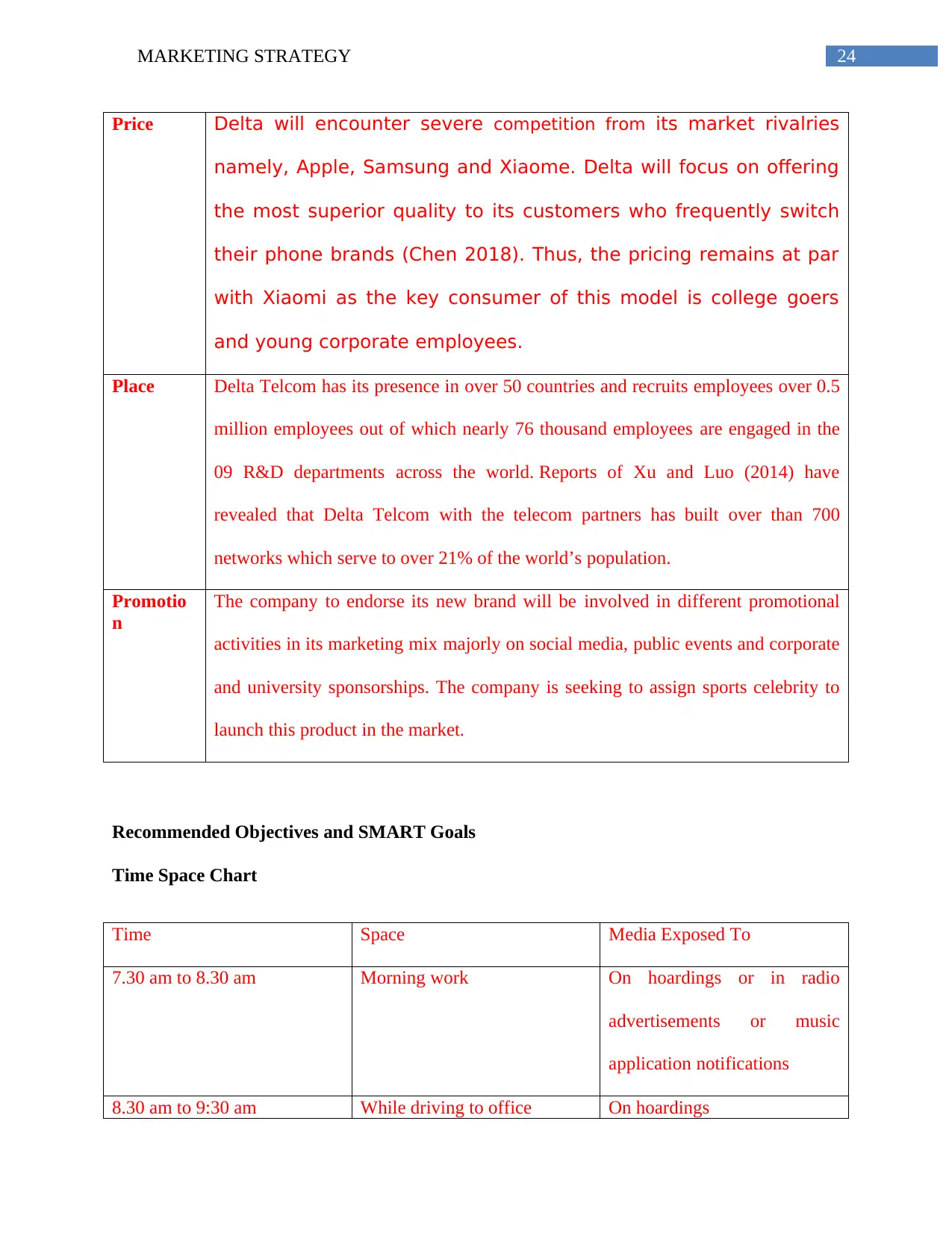
24MARKETING STRATEGY
Price Delta will encounter severe competition from its market rivalries
namely, Apple, Samsung and Xiaome. Delta will focus on offering
the most superior quality to its customers who frequently switch
their phone brands (Chen 2018). Thus, the pricing remains at par
with Xiaomi as the key consumer of this model is college goers
and young corporate employees.
Place Delta Telcom has its presence in over 50 countries and recruits employees over 0.5
million employees out of which nearly 76 thousand employees are engaged in the
09 R&D departments across the world. Reports of Xu and Luo (2014) have
revealed that Delta Telcom with the telecom partners has built over than 700
networks which serve to over 21% of the world’s population.
Promotio
n
The company to endorse its new brand will be involved in different promotional
activities in its marketing mix majorly on social media, public events and corporate
and university sponsorships. The company is seeking to assign sports celebrity to
launch this product in the market.
Recommended Objectives and SMART Goals
Time Space Chart
Time Space Media Exposed To
7.30 am to 8.30 am Morning work On hoardings or in radio
advertisements or music
application notifications
8.30 am to 9:30 am While driving to office On hoardings
Price Delta will encounter severe competition from its market rivalries
namely, Apple, Samsung and Xiaome. Delta will focus on offering
the most superior quality to its customers who frequently switch
their phone brands (Chen 2018). Thus, the pricing remains at par
with Xiaomi as the key consumer of this model is college goers
and young corporate employees.
Place Delta Telcom has its presence in over 50 countries and recruits employees over 0.5
million employees out of which nearly 76 thousand employees are engaged in the
09 R&D departments across the world. Reports of Xu and Luo (2014) have
revealed that Delta Telcom with the telecom partners has built over than 700
networks which serve to over 21% of the world’s population.
Promotio
n
The company to endorse its new brand will be involved in different promotional
activities in its marketing mix majorly on social media, public events and corporate
and university sponsorships. The company is seeking to assign sports celebrity to
launch this product in the market.
Recommended Objectives and SMART Goals
Time Space Chart
Time Space Media Exposed To
7.30 am to 8.30 am Morning work On hoardings or in radio
advertisements or music
application notifications
8.30 am to 9:30 am While driving to office On hoardings
Paraphrase This Document
Need a fresh take? Get an instant paraphrase of this document with our AI Paraphraser
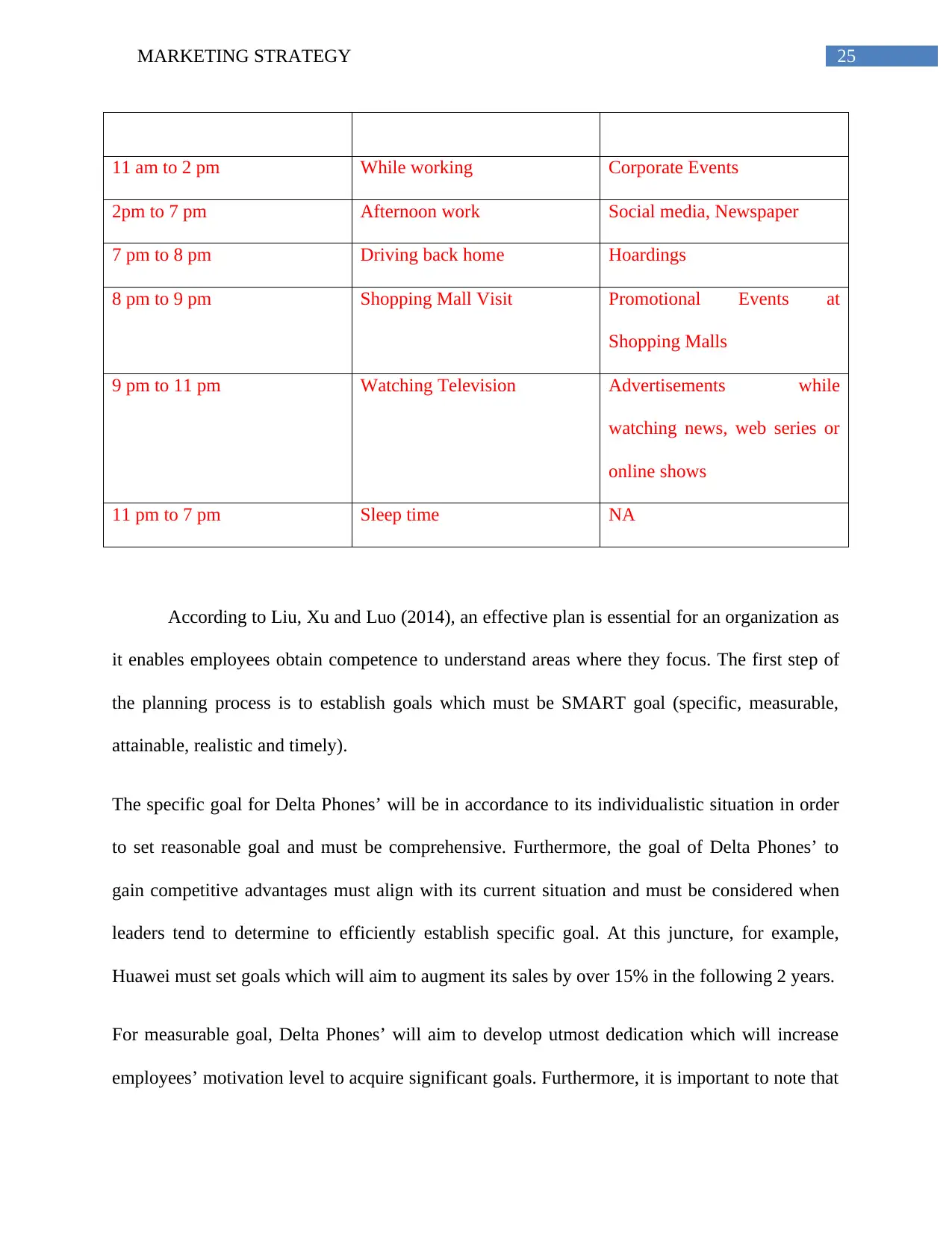
25MARKETING STRATEGY
11 am to 2 pm While working Corporate Events
2pm to 7 pm Afternoon work Social media, Newspaper
7 pm to 8 pm Driving back home Hoardings
8 pm to 9 pm Shopping Mall Visit Promotional Events at
Shopping Malls
9 pm to 11 pm Watching Television Advertisements while
watching news, web series or
online shows
11 pm to 7 pm Sleep time NA
According to Liu, Xu and Luo (2014), an effective plan is essential for an organization as
it enables employees obtain competence to understand areas where they focus. The first step of
the planning process is to establish goals which must be SMART goal (specific, measurable,
attainable, realistic and timely).
The specific goal for Delta Phones’ will be in accordance to its individualistic situation in order
to set reasonable goal and must be comprehensive. Furthermore, the goal of Delta Phones’ to
gain competitive advantages must align with its current situation and must be considered when
leaders tend to determine to efficiently establish specific goal. At this juncture, for example,
Huawei must set goals which will aim to augment its sales by over 15% in the following 2 years.
For measurable goal, Delta Phones’ will aim to develop utmost dedication which will increase
employees’ motivation level to acquire significant goals. Furthermore, it is important to note that
11 am to 2 pm While working Corporate Events
2pm to 7 pm Afternoon work Social media, Newspaper
7 pm to 8 pm Driving back home Hoardings
8 pm to 9 pm Shopping Mall Visit Promotional Events at
Shopping Malls
9 pm to 11 pm Watching Television Advertisements while
watching news, web series or
online shows
11 pm to 7 pm Sleep time NA
According to Liu, Xu and Luo (2014), an effective plan is essential for an organization as
it enables employees obtain competence to understand areas where they focus. The first step of
the planning process is to establish goals which must be SMART goal (specific, measurable,
attainable, realistic and timely).
The specific goal for Delta Phones’ will be in accordance to its individualistic situation in order
to set reasonable goal and must be comprehensive. Furthermore, the goal of Delta Phones’ to
gain competitive advantages must align with its current situation and must be considered when
leaders tend to determine to efficiently establish specific goal. At this juncture, for example,
Huawei must set goals which will aim to augment its sales by over 15% in the following 2 years.
For measurable goal, Delta Phones’ will aim to develop utmost dedication which will increase
employees’ motivation level to acquire significant goals. Furthermore, it is important to note that

26MARKETING STRATEGY
when modern organizations constitute specific target and determination to achieve a goal, they
must aim to develop several valuable action plans. These plans and strategies will efficiently
enable the company to successfully accomplish goal. For attaining the goal, Delta Phones’ at this
level must evaluate its progress toward goal achievement. In this step, the goal setters of the
company will require to persuade the procedure all the time in order to complete goal in
successful manner. However, it is important to note that at certain situations, workers will tend to
misinterpret the established goal. Consequently, the goal setters may show incompetence in
finishing the goal successfully. The last step must efficiently rely on maintaining flexibility.
Recommendations
`Through marketing strategy, Delta Phones’ should use its own advantages of resources
in order to increase the publicly of its smartphones brand. Furthermore, the organization should
primarily focus on user’s experience in creating brand value through technological innovation
(Shiu and Yasumoto 2015). Additionally, in relation to its Segmentation Targeting & Positioning
analysis, Huawei should efficiently continue to implement the various strategies to persuade the
demand of Delta Phones’ target market and further develop its market share. Delta Phones’
should further pay significant amount of attention to the production of smartphones and its
design to further reduce product development time. Furthermore, Delta Phones’ should
proficiently continue to introduce its own brand smartphones with exceptional innovative
features in addition to after-sale services, which will be identified as a core component towards
its achievement whereby it will aid the company to develop available customers along with
noteworthy user experience, as a consequence guaranteeing customer loyalty (Zeschky,
Winterhalter and Gassmann 2014).
when modern organizations constitute specific target and determination to achieve a goal, they
must aim to develop several valuable action plans. These plans and strategies will efficiently
enable the company to successfully accomplish goal. For attaining the goal, Delta Phones’ at this
level must evaluate its progress toward goal achievement. In this step, the goal setters of the
company will require to persuade the procedure all the time in order to complete goal in
successful manner. However, it is important to note that at certain situations, workers will tend to
misinterpret the established goal. Consequently, the goal setters may show incompetence in
finishing the goal successfully. The last step must efficiently rely on maintaining flexibility.
Recommendations
`Through marketing strategy, Delta Phones’ should use its own advantages of resources
in order to increase the publicly of its smartphones brand. Furthermore, the organization should
primarily focus on user’s experience in creating brand value through technological innovation
(Shiu and Yasumoto 2015). Additionally, in relation to its Segmentation Targeting & Positioning
analysis, Huawei should efficiently continue to implement the various strategies to persuade the
demand of Delta Phones’ target market and further develop its market share. Delta Phones’
should further pay significant amount of attention to the production of smartphones and its
design to further reduce product development time. Furthermore, Delta Phones’ should
proficiently continue to introduce its own brand smartphones with exceptional innovative
features in addition to after-sale services, which will be identified as a core component towards
its achievement whereby it will aid the company to develop available customers along with
noteworthy user experience, as a consequence guaranteeing customer loyalty (Zeschky,
Winterhalter and Gassmann 2014).
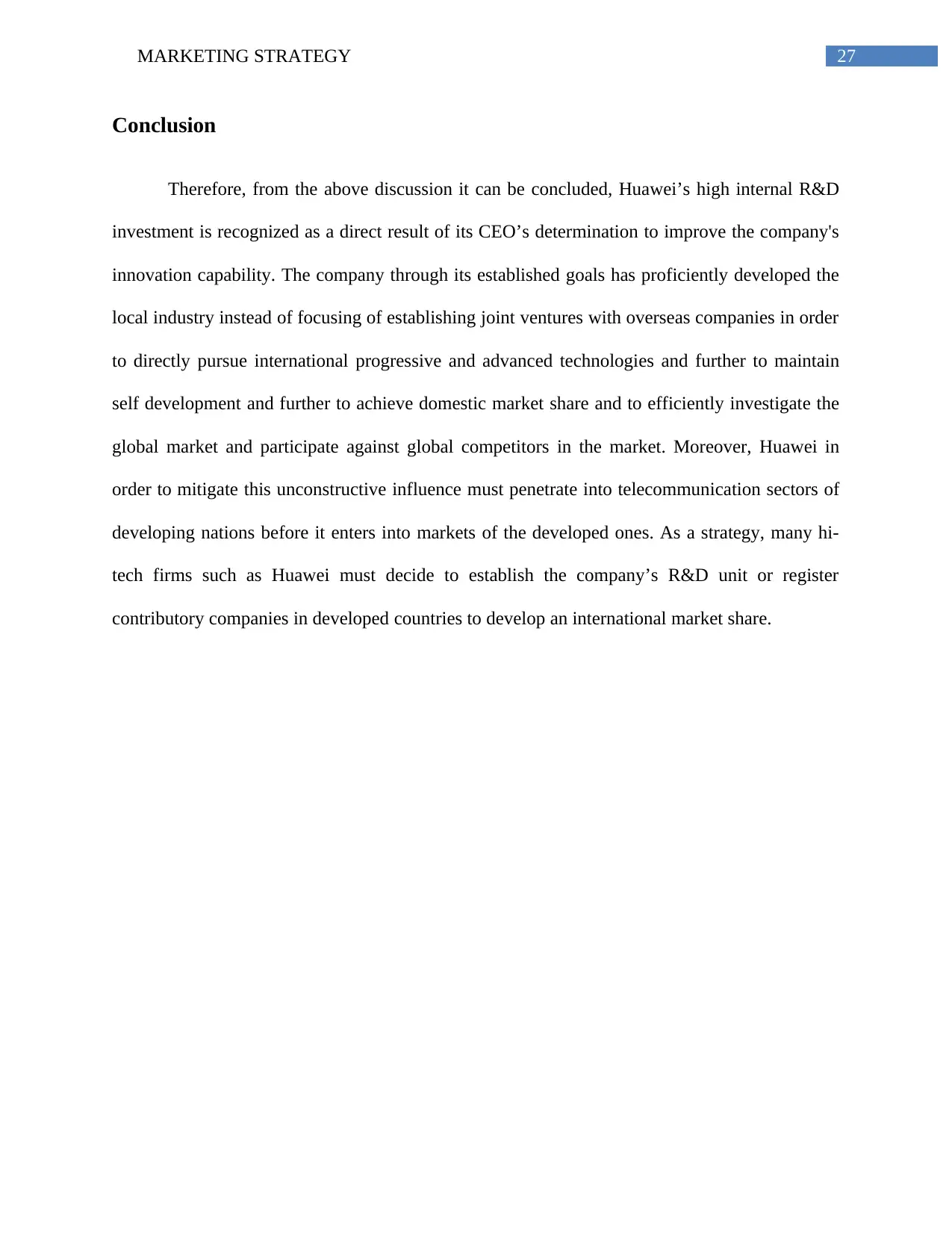
27MARKETING STRATEGY
Conclusion
Therefore, from the above discussion it can be concluded, Huawei’s high internal R&D
investment is recognized as a direct result of its CEO’s determination to improve the company's
innovation capability. The company through its established goals has proficiently developed the
local industry instead of focusing of establishing joint ventures with overseas companies in order
to directly pursue international progressive and advanced technologies and further to maintain
self development and further to achieve domestic market share and to efficiently investigate the
global market and participate against global competitors in the market. Moreover, Huawei in
order to mitigate this unconstructive influence must penetrate into telecommunication sectors of
developing nations before it enters into markets of the developed ones. As a strategy, many hi-
tech firms such as Huawei must decide to establish the company’s R&D unit or register
contributory companies in developed countries to develop an international market share.
Conclusion
Therefore, from the above discussion it can be concluded, Huawei’s high internal R&D
investment is recognized as a direct result of its CEO’s determination to improve the company's
innovation capability. The company through its established goals has proficiently developed the
local industry instead of focusing of establishing joint ventures with overseas companies in order
to directly pursue international progressive and advanced technologies and further to maintain
self development and further to achieve domestic market share and to efficiently investigate the
global market and participate against global competitors in the market. Moreover, Huawei in
order to mitigate this unconstructive influence must penetrate into telecommunication sectors of
developing nations before it enters into markets of the developed ones. As a strategy, many hi-
tech firms such as Huawei must decide to establish the company’s R&D unit or register
contributory companies in developed countries to develop an international market share.
Secure Best Marks with AI Grader
Need help grading? Try our AI Grader for instant feedback on your assignments.
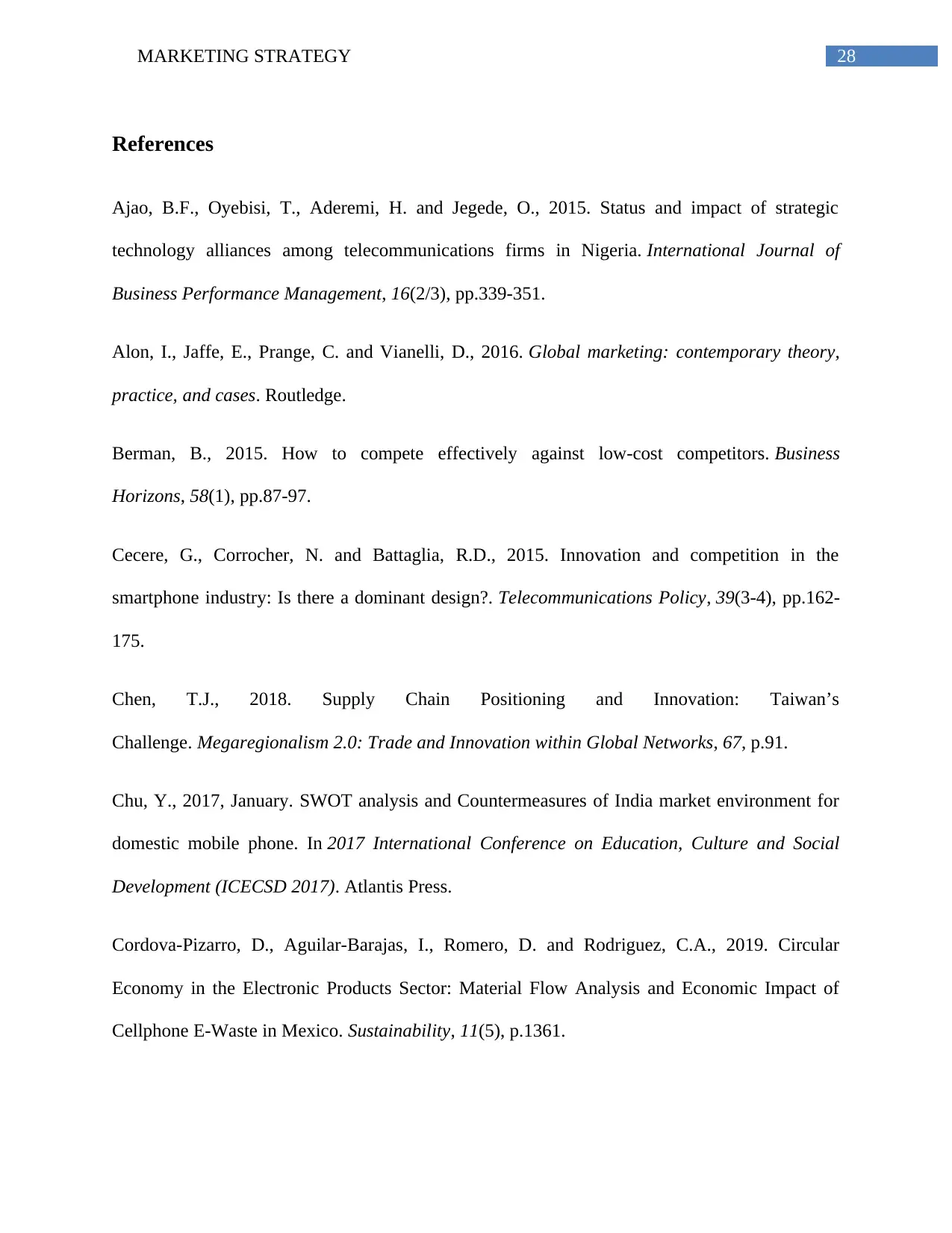
28MARKETING STRATEGY
References
Ajao, B.F., Oyebisi, T., Aderemi, H. and Jegede, O., 2015. Status and impact of strategic
technology alliances among telecommunications firms in Nigeria. International Journal of
Business Performance Management, 16(2/3), pp.339-351.
Alon, I., Jaffe, E., Prange, C. and Vianelli, D., 2016. Global marketing: contemporary theory,
practice, and cases. Routledge.
Berman, B., 2015. How to compete effectively against low-cost competitors. Business
Horizons, 58(1), pp.87-97.
Cecere, G., Corrocher, N. and Battaglia, R.D., 2015. Innovation and competition in the
smartphone industry: Is there a dominant design?. Telecommunications Policy, 39(3-4), pp.162-
175.
Chen, T.J., 2018. Supply Chain Positioning and Innovation: Taiwan’s
Challenge. Megaregionalism 2.0: Trade and Innovation within Global Networks, 67, p.91.
Chu, Y., 2017, January. SWOT analysis and Countermeasures of India market environment for
domestic mobile phone. In 2017 International Conference on Education, Culture and Social
Development (ICECSD 2017). Atlantis Press.
Cordova-Pizarro, D., Aguilar-Barajas, I., Romero, D. and Rodriguez, C.A., 2019. Circular
Economy in the Electronic Products Sector: Material Flow Analysis and Economic Impact of
Cellphone E-Waste in Mexico. Sustainability, 11(5), p.1361.
References
Ajao, B.F., Oyebisi, T., Aderemi, H. and Jegede, O., 2015. Status and impact of strategic
technology alliances among telecommunications firms in Nigeria. International Journal of
Business Performance Management, 16(2/3), pp.339-351.
Alon, I., Jaffe, E., Prange, C. and Vianelli, D., 2016. Global marketing: contemporary theory,
practice, and cases. Routledge.
Berman, B., 2015. How to compete effectively against low-cost competitors. Business
Horizons, 58(1), pp.87-97.
Cecere, G., Corrocher, N. and Battaglia, R.D., 2015. Innovation and competition in the
smartphone industry: Is there a dominant design?. Telecommunications Policy, 39(3-4), pp.162-
175.
Chen, T.J., 2018. Supply Chain Positioning and Innovation: Taiwan’s
Challenge. Megaregionalism 2.0: Trade and Innovation within Global Networks, 67, p.91.
Chu, Y., 2017, January. SWOT analysis and Countermeasures of India market environment for
domestic mobile phone. In 2017 International Conference on Education, Culture and Social
Development (ICECSD 2017). Atlantis Press.
Cordova-Pizarro, D., Aguilar-Barajas, I., Romero, D. and Rodriguez, C.A., 2019. Circular
Economy in the Electronic Products Sector: Material Flow Analysis and Economic Impact of
Cellphone E-Waste in Mexico. Sustainability, 11(5), p.1361.
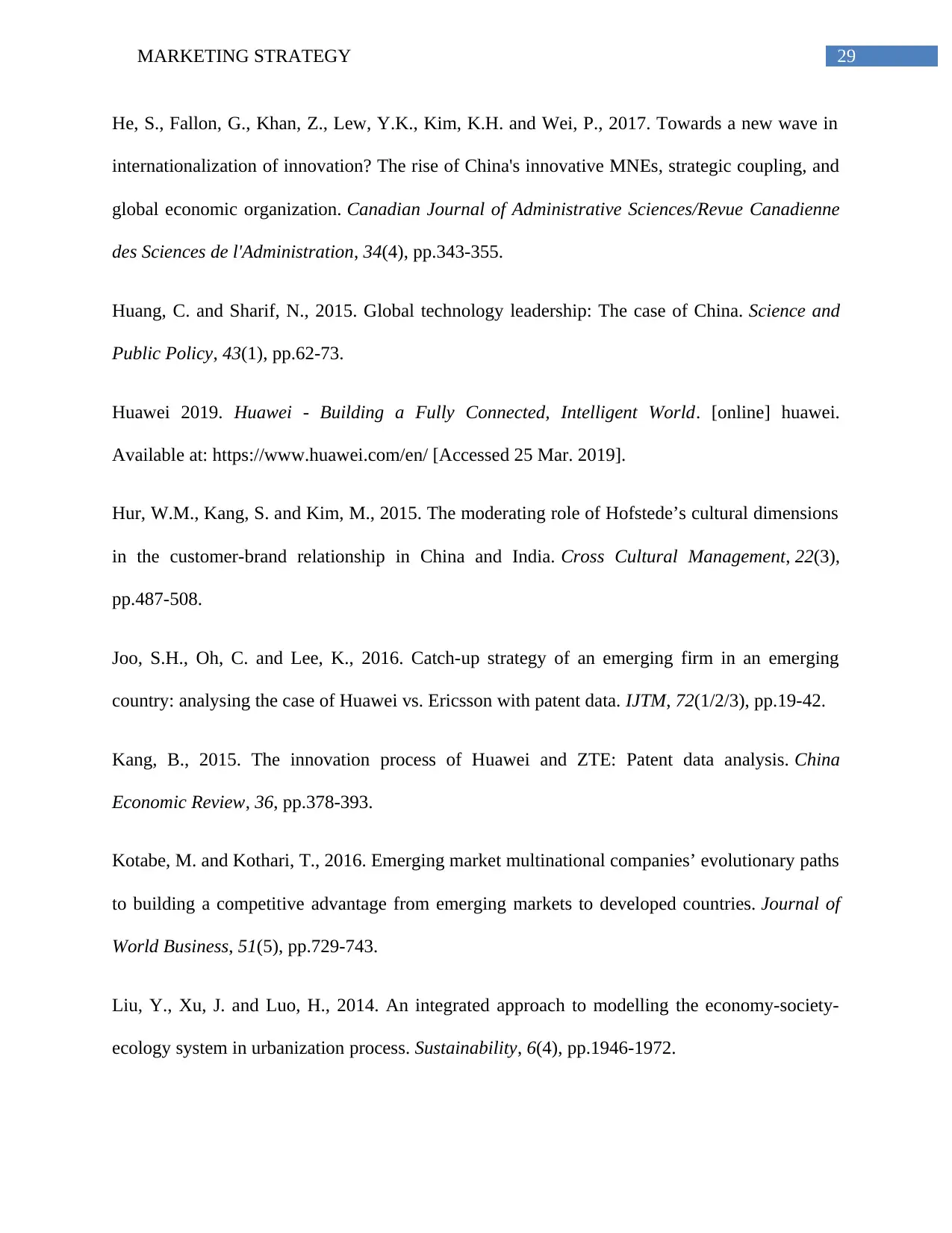
29MARKETING STRATEGY
He, S., Fallon, G., Khan, Z., Lew, Y.K., Kim, K.H. and Wei, P., 2017. Towards a new wave in
internationalization of innovation? The rise of China's innovative MNEs, strategic coupling, and
global economic organization. Canadian Journal of Administrative Sciences/Revue Canadienne
des Sciences de l'Administration, 34(4), pp.343-355.
Huang, C. and Sharif, N., 2015. Global technology leadership: The case of China. Science and
Public Policy, 43(1), pp.62-73.
Huawei 2019. Huawei - Building a Fully Connected, Intelligent World. [online] huawei.
Available at: https://www.huawei.com/en/ [Accessed 25 Mar. 2019].
Hur, W.M., Kang, S. and Kim, M., 2015. The moderating role of Hofstede’s cultural dimensions
in the customer-brand relationship in China and India. Cross Cultural Management, 22(3),
pp.487-508.
Joo, S.H., Oh, C. and Lee, K., 2016. Catch-up strategy of an emerging firm in an emerging
country: analysing the case of Huawei vs. Ericsson with patent data. IJTM, 72(1/2/3), pp.19-42.
Kang, B., 2015. The innovation process of Huawei and ZTE: Patent data analysis. China
Economic Review, 36, pp.378-393.
Kotabe, M. and Kothari, T., 2016. Emerging market multinational companies’ evolutionary paths
to building a competitive advantage from emerging markets to developed countries. Journal of
World Business, 51(5), pp.729-743.
Liu, Y., Xu, J. and Luo, H., 2014. An integrated approach to modelling the economy-society-
ecology system in urbanization process. Sustainability, 6(4), pp.1946-1972.
He, S., Fallon, G., Khan, Z., Lew, Y.K., Kim, K.H. and Wei, P., 2017. Towards a new wave in
internationalization of innovation? The rise of China's innovative MNEs, strategic coupling, and
global economic organization. Canadian Journal of Administrative Sciences/Revue Canadienne
des Sciences de l'Administration, 34(4), pp.343-355.
Huang, C. and Sharif, N., 2015. Global technology leadership: The case of China. Science and
Public Policy, 43(1), pp.62-73.
Huawei 2019. Huawei - Building a Fully Connected, Intelligent World. [online] huawei.
Available at: https://www.huawei.com/en/ [Accessed 25 Mar. 2019].
Hur, W.M., Kang, S. and Kim, M., 2015. The moderating role of Hofstede’s cultural dimensions
in the customer-brand relationship in China and India. Cross Cultural Management, 22(3),
pp.487-508.
Joo, S.H., Oh, C. and Lee, K., 2016. Catch-up strategy of an emerging firm in an emerging
country: analysing the case of Huawei vs. Ericsson with patent data. IJTM, 72(1/2/3), pp.19-42.
Kang, B., 2015. The innovation process of Huawei and ZTE: Patent data analysis. China
Economic Review, 36, pp.378-393.
Kotabe, M. and Kothari, T., 2016. Emerging market multinational companies’ evolutionary paths
to building a competitive advantage from emerging markets to developed countries. Journal of
World Business, 51(5), pp.729-743.
Liu, Y., Xu, J. and Luo, H., 2014. An integrated approach to modelling the economy-society-
ecology system in urbanization process. Sustainability, 6(4), pp.1946-1972.
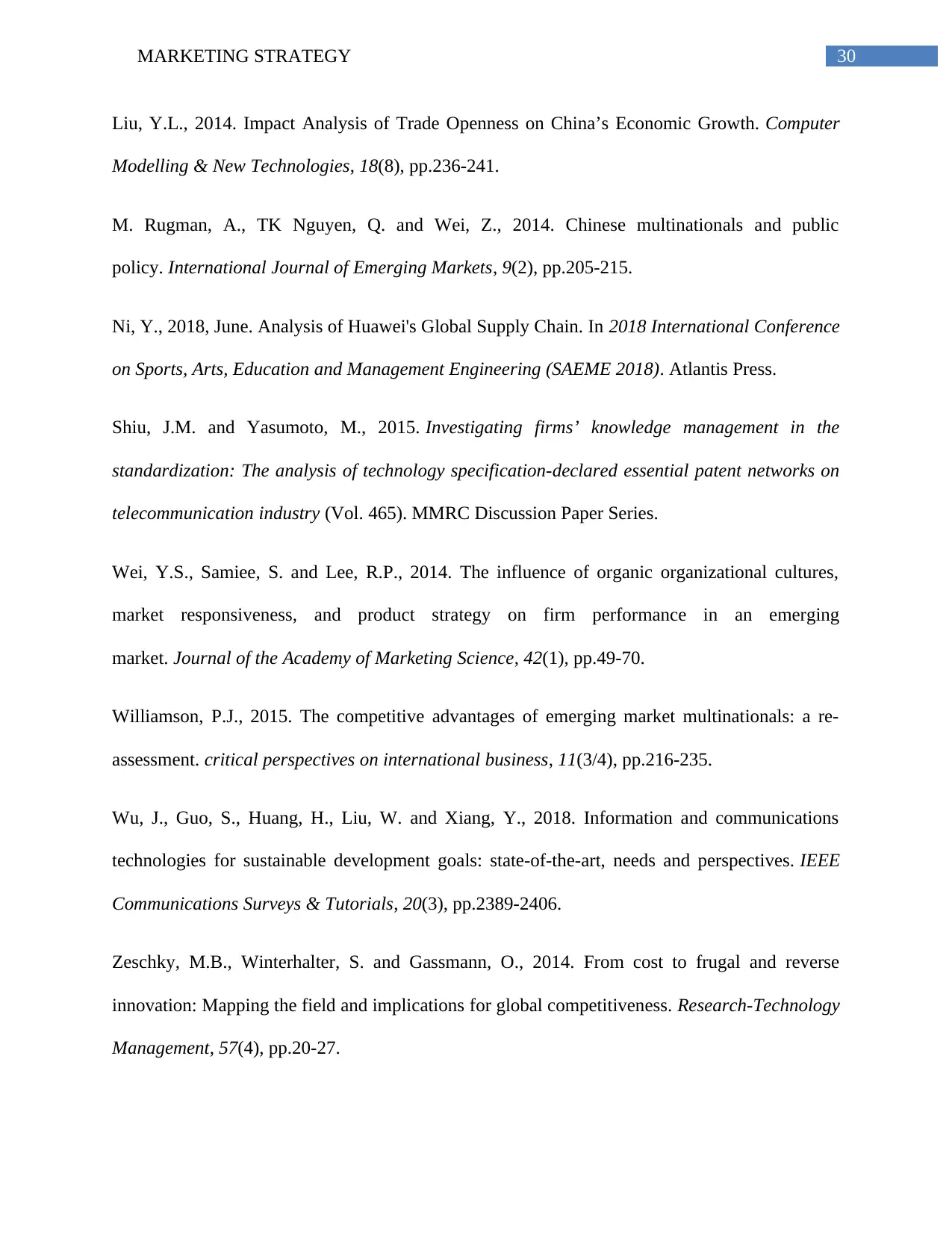
30MARKETING STRATEGY
Liu, Y.L., 2014. Impact Analysis of Trade Openness on China’s Economic Growth. Computer
Modelling & New Technologies, 18(8), pp.236-241.
M. Rugman, A., TK Nguyen, Q. and Wei, Z., 2014. Chinese multinationals and public
policy. International Journal of Emerging Markets, 9(2), pp.205-215.
Ni, Y., 2018, June. Analysis of Huawei's Global Supply Chain. In 2018 International Conference
on Sports, Arts, Education and Management Engineering (SAEME 2018). Atlantis Press.
Shiu, J.M. and Yasumoto, M., 2015. Investigating firms’ knowledge management in the
standardization: The analysis of technology specification-declared essential patent networks on
telecommunication industry (Vol. 465). MMRC Discussion Paper Series.
Wei, Y.S., Samiee, S. and Lee, R.P., 2014. The influence of organic organizational cultures,
market responsiveness, and product strategy on firm performance in an emerging
market. Journal of the Academy of Marketing Science, 42(1), pp.49-70.
Williamson, P.J., 2015. The competitive advantages of emerging market multinationals: a re-
assessment. critical perspectives on international business, 11(3/4), pp.216-235.
Wu, J., Guo, S., Huang, H., Liu, W. and Xiang, Y., 2018. Information and communications
technologies for sustainable development goals: state-of-the-art, needs and perspectives. IEEE
Communications Surveys & Tutorials, 20(3), pp.2389-2406.
Zeschky, M.B., Winterhalter, S. and Gassmann, O., 2014. From cost to frugal and reverse
innovation: Mapping the field and implications for global competitiveness. Research-Technology
Management, 57(4), pp.20-27.
Liu, Y.L., 2014. Impact Analysis of Trade Openness on China’s Economic Growth. Computer
Modelling & New Technologies, 18(8), pp.236-241.
M. Rugman, A., TK Nguyen, Q. and Wei, Z., 2014. Chinese multinationals and public
policy. International Journal of Emerging Markets, 9(2), pp.205-215.
Ni, Y., 2018, June. Analysis of Huawei's Global Supply Chain. In 2018 International Conference
on Sports, Arts, Education and Management Engineering (SAEME 2018). Atlantis Press.
Shiu, J.M. and Yasumoto, M., 2015. Investigating firms’ knowledge management in the
standardization: The analysis of technology specification-declared essential patent networks on
telecommunication industry (Vol. 465). MMRC Discussion Paper Series.
Wei, Y.S., Samiee, S. and Lee, R.P., 2014. The influence of organic organizational cultures,
market responsiveness, and product strategy on firm performance in an emerging
market. Journal of the Academy of Marketing Science, 42(1), pp.49-70.
Williamson, P.J., 2015. The competitive advantages of emerging market multinationals: a re-
assessment. critical perspectives on international business, 11(3/4), pp.216-235.
Wu, J., Guo, S., Huang, H., Liu, W. and Xiang, Y., 2018. Information and communications
technologies for sustainable development goals: state-of-the-art, needs and perspectives. IEEE
Communications Surveys & Tutorials, 20(3), pp.2389-2406.
Zeschky, M.B., Winterhalter, S. and Gassmann, O., 2014. From cost to frugal and reverse
innovation: Mapping the field and implications for global competitiveness. Research-Technology
Management, 57(4), pp.20-27.
Paraphrase This Document
Need a fresh take? Get an instant paraphrase of this document with our AI Paraphraser
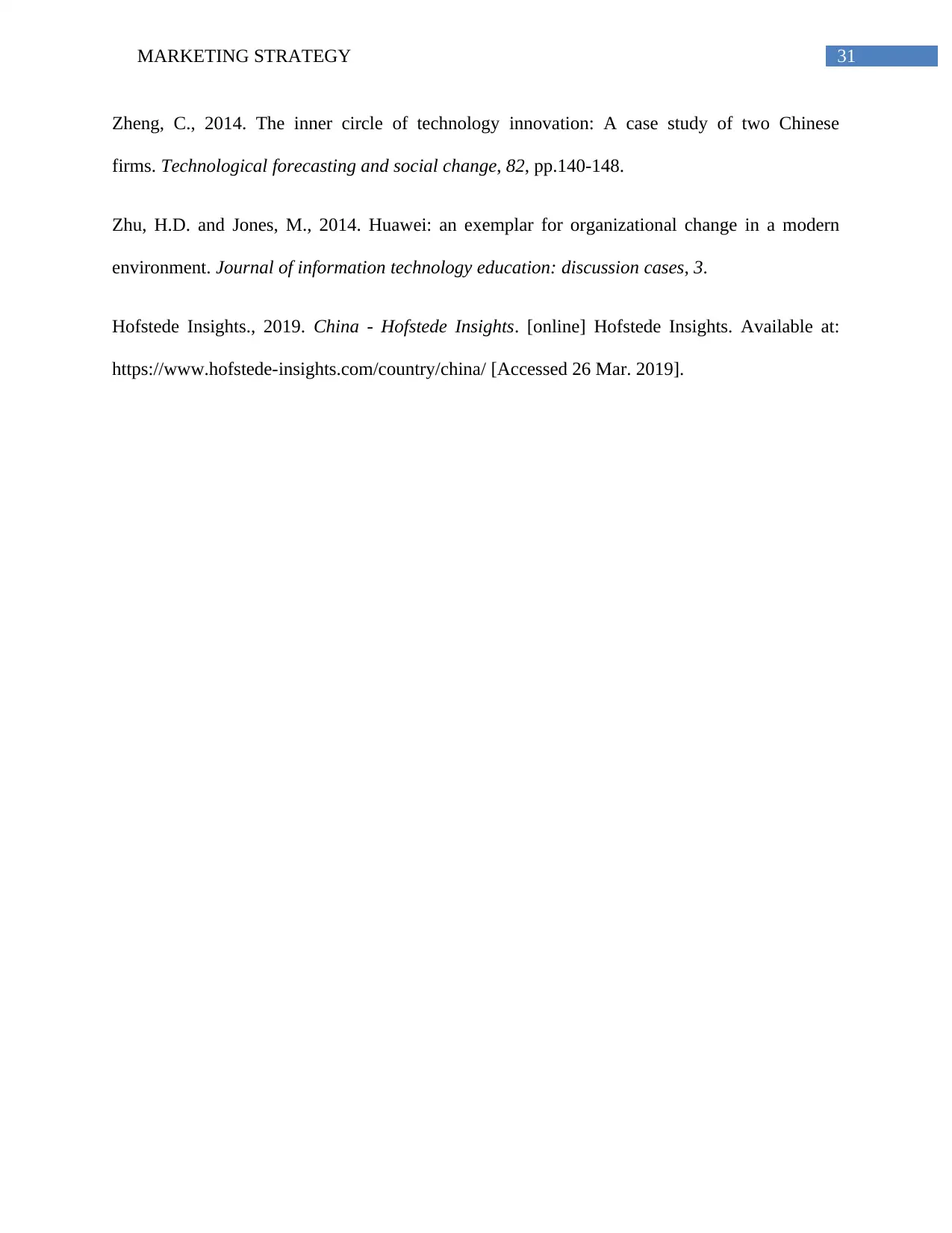
31MARKETING STRATEGY
Zheng, C., 2014. The inner circle of technology innovation: A case study of two Chinese
firms. Technological forecasting and social change, 82, pp.140-148.
Zhu, H.D. and Jones, M., 2014. Huawei: an exemplar for organizational change in a modern
environment. Journal of information technology education: discussion cases, 3.
Hofstede Insights., 2019. China - Hofstede Insights. [online] Hofstede Insights. Available at:
https://www.hofstede-insights.com/country/china/ [Accessed 26 Mar. 2019].
Zheng, C., 2014. The inner circle of technology innovation: A case study of two Chinese
firms. Technological forecasting and social change, 82, pp.140-148.
Zhu, H.D. and Jones, M., 2014. Huawei: an exemplar for organizational change in a modern
environment. Journal of information technology education: discussion cases, 3.
Hofstede Insights., 2019. China - Hofstede Insights. [online] Hofstede Insights. Available at:
https://www.hofstede-insights.com/country/china/ [Accessed 26 Mar. 2019].
1 out of 32
Related Documents
Your All-in-One AI-Powered Toolkit for Academic Success.
+13062052269
info@desklib.com
Available 24*7 on WhatsApp / Email
![[object Object]](/_next/static/media/star-bottom.7253800d.svg)
Unlock your academic potential
© 2024 | Zucol Services PVT LTD | All rights reserved.





